Fisherman
A fisherman from La Reforma releases a sea turtle in Santa María Bay, illustrating how environmental education and training programs are fostering conservation efforts for these vital species within the ecosystem.
In the heart of Santa María Bay, a group of female fishers is breaking gender barriers and leading a sustainable oyster-farming project that not only provides income but also helps revive one of the Gulf of California’s most vital wetlands—threatened by pollution and violence.
By Raquel Zapien
Dawn hasn’t yet broken. On the shoreline, six women stand waist-deep in water. They climb into a panga, a small fishing boat, and head out into Santa María Bay in Angostura, Sinaloa. There, brushes in hand, they scrub the mesh bags where oysters grow, making sure sand doesn’t clog the openings so the oysters can feed. The only sound is the rasp of the brush against the mesh—repeatedly. Every day. Until the larvae, carried by the ebb and flow of the tides, grow large enough to need less care. In the meantime, on some nights, they camp beside their young oysters, lulled by the gentle murmur of the waves.
These women are members of the Leonor Cuadras Cuadras Cooperative—the first in the fishing village of La Reforma, less than an hour from Culiacán, to be formed entirely by women: Magdalena Burgos Cuadras, Nora Celma González García, María Evelia Sauceda Sánchez, and sisters Carmen Alicia and Teresita de Jesús Camacho Camacho.
Just two years ago, they were not allowed to join cooperatives. They could accompany their husbands on shrimping trips or fish on their own, with no support, but they weren’t registered as members and had no voice in decision-making. Today, they farm oysters not only to earn income during the closed seasons—when shrimp and crab can no longer sustain them—but also to help restore Santa María Bay, a vital wetland of the Gulf of California now under threat from pollution and overfishing.

At dawn over Santa María Bay, Sinaloa, the still waters frame the oyster farms of El Espíritu Island, where rows of suspended oyster bags can be seen drifting across the water. This area, part of the port of La Reforma—once a thriving center of fishing activity—now bears signs of decline and desolation, a consequence of violent episodes that have shaken the region.
Photo: Ramón Eduardo Hernández Montoya
They chose the name Leonor Cuadras Cuadras in honor of a woman who went to sea at a time when doors were closed to women. “My mom and my aunts were fishers,” recalls Magdalena Burgos Cuadras, president of the organization. “Back then, women weren’t welcome in cooperatives, but they worked just as hard as any man.” Naming the cooperative after her mother was an act of recognition—a tribute to someone who, by stepping into a trade that excluded women, helped open the way for generations to come.
By baking and selling hundreds of coricos (corn cookies), panelas (sweet breads), and bizcotelas (biscuits), they managed to raise the 14,000 pesos needed to pay the notary and legally establish the cooperative. The traditional Sinaloan cookies—sold for ten pesos a bag—became the driving force behind a shared cause.
But how did they get to this point? Over the years, the community of La Reforma began to renew itself through workshops on leadership, environmental management, and entrepreneurship. Around 80 men and women took part in these training sessions, promoted by the local organization Sociedad en Acción de Sinaloa (Sucede), which has been working in the area for eight years through a strategy of social and environmental engagement. In this town of just 6,600 inhabitants, nearly a quarter—about 1,800 residents—participated in activities that focused not only on conserving the bay but also on promoting well-being, equity, and social justice.
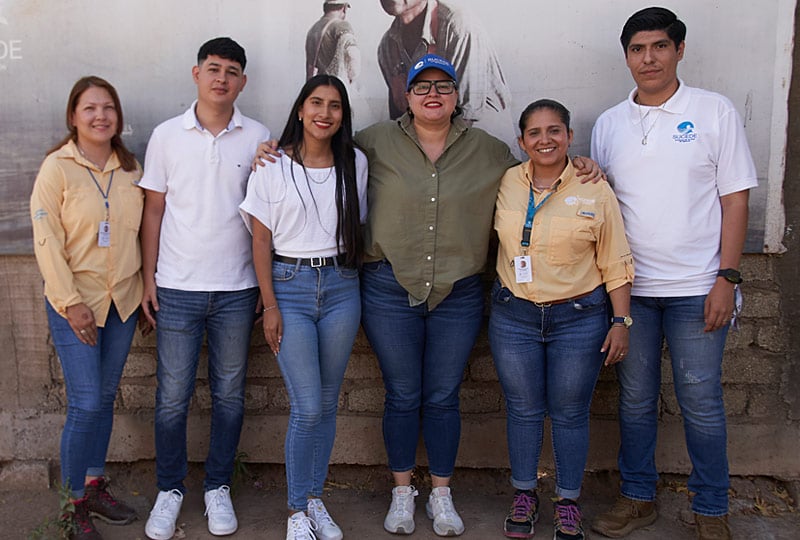
The team from Sociedad en Acción de Sinaloa (Sucede), an organization dedicated to restoring Santa María Bay, works to improve environmental conditions and support local fishing communities. From left to right: Alejandra Valenzuela, Ramón Eduardo Hernández Montoya, María Guadalupe López Gutiérrez, Isabel Mendoza, Areli Coronado, and Víctor Manuel Meza Castro.
Photo: Eunice Adorno
It was on this ground that the idea of forming an oyster-farming cooperative first took root. “Women weren’t given opportunities, so we joined Sucede,” says Magdalena, better known as Chita Burgos. “We attended a course on reconciliation and forgiveness; from there, we all came together and felt that spark—the urge to start a cooperative with gender equity.” The association provided them with legal guidance, while the Santa María Sea Food company trained them in oyster cultivation.
Community work was, in fact, the first step toward change. In 2023, they received their articles of incorporation and began their first planting: 3.5 million oysters, which they tended until they matured for Santa María Sea Food. The company supplied larvae, trained them, and paid 50 cents per oyster. More than a source of income, the experience gave them confidence—it proved they could produce at scale and sustain a project of their own.
The Leonor Cuadras Cuadras Cooperative puts into practice some of the pillars proposed within the Marine Prosperity Areas (MPpAs): it organized its economy around oysters; generated employment during the shrimp and crab closed seasons; and, at the same time, contributed to wetland regeneration.
In 2024, they planted another million oyster seeds in the cultivation area set up on Espíritu Island. This time, it wasn’t for sale, but part of a complementary restoration effort. As they grow, these filter-feeding mollusks help purify the bay’s waters, fostering the recovery of other species and making the ecosystem more productive—with the future in mind. “That’s what we want: to help the environment and make the waters cleaner,” says Chita Burgos.
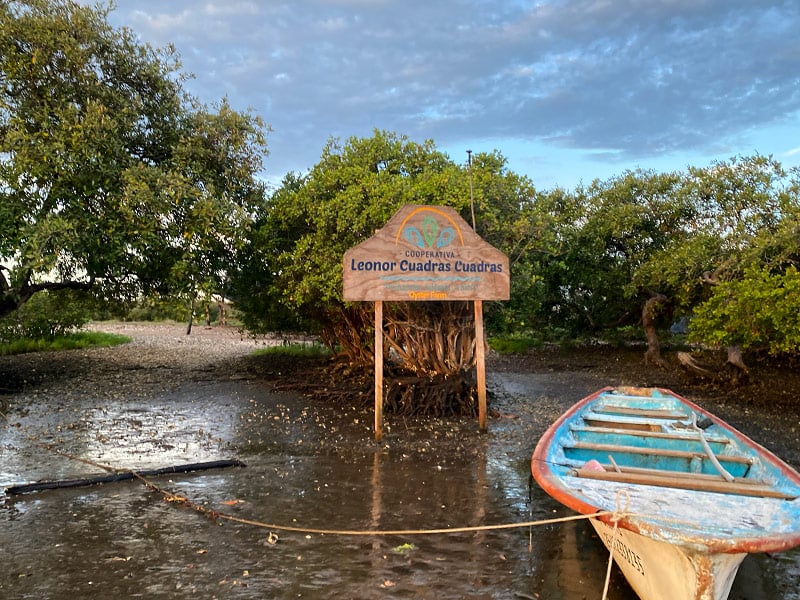
Amid the mangroves of El Espíritu Island in Santa María Bay, Sinaloa, stands the sign of the Leonor Cuadras Cuadras Oyster Cooperative—the first in the state made up entirely of women fishers. Beside it rests the small boat Ángela, used to navigate the oyster farming lines, a testament to these women’s commitment to sustainable aquaculture and the conservation of their environment.
Photo: Ramón Eduardo Hernández Montoya
They know the community’s survival depends on the bay—and the bay, in turn, depends on the community to protect its mangroves, islands, islets, dunes, and coastal lagoons, which together stretch across 67,000 hectares in the municipalities of Navolato, Angostura, and Guasave.
In La Reforma, a town that lives primarily from fishing, the members of the Leonor Cuadras Cuadras Cooperative are charting a new course for conservation. In just six years, they have gone from being dismissed to leading the protection of Santa María Bay, declared a protected natural area in August 2001.
In August 2025, the women of the cooperative once again mixed corn and wheat flour—just as their mothers and grandmothers did—to bake cookies and empanadas. There was no work, neither on land nor at sea. Shrimp was in its closed season, crab catches barely brought in anything, prices had been stagnant for years, and diesel costs kept rising.
They and their community are searching for ways to survive in a climate of insecurity that keeps them from getting into a boat—or even walking down the street—without fear. Since drug-related violence erupted in Sinaloa in September 2024, everything has changed: shootings, disappearances, kidnappings. In La Reforma, families know that any day can be cut short by a new act of violence—and that everyday life depends on "the situation calming down."
That's why, in the last two months, they haven't returned to the oyster beds to work either; the oysters have been left unattended.
Investors interested in hiring the cooperative have also not returned; they are waiting for security conditions to improve before resuming business and allowing production to continue.
Amidst this uncertainty, the women hold on to what they have—their hands, their recipes, their community. Tamales have now joined the list of activities to earn a little extra income. “We’re warriors,” says Chita Burgos with a laugh—though she means it.
She and her fellow members haven’t lost hope that the violence will give way to calls for peace, and that they’ll soon be able to return to small-scale fishing—a sector in which women make up 90% of the global workforce, according to research published in Nature.
As they wait for that moment to come, the women focus on adapting and keeping a positive outlook—especially after receiving their own motorboat on August 26 through a state support program that covered half the cost. The cooperative paid the remaining 140,000 pesos with the earnings from their first oyster sale.
Step by step, they have built the foundations that uphold the Marine Prosperity Areas. First came community participation—through workshops, organization, and the autonomy to speak up and make decisions. Then came capacity building and governance, strengthened by training, legal support, and new alliances. And although there is still a long road ahead—establishing clear local governance frameworks, conflict-resolution mechanisms, and infrastructure to diversify income, such as ecotourism—they have already begun writing a different story: one in which the future of the bay and the community pulse in unison.
In the waters of Santa María Bay, other hopes also set sail: pangas that no longer head out to fish for shrimp, but to showcase birds, islands, and sea turtles—as if each species were a reminder of what remains to be protected.
La Reforma is known for having some of Mexico’s richest fishing grounds and for distributing blue shrimp, the species with the highest commercial value. But when shrimp and crab closed seasons overlap, the bay falls almost silent: pangas are few, and work is minimal. It was then that Adalberto García Domínguez and a group of men and women decided to open another door—forming an ecotourism and sport-fishing cooperative offering tours of Santa María Bay, a feeding and resting site for over 500,000 shorebirds and thousands of waterfowl.

The boardwalk in La Reforma, adorned with a bird sculpture, celebrates the ornithological richness of Santa María Bay. This region, home to thousands of migratory birds, offers vast potential for sustainable ecotourism.
Photo: Eunice Adorno
They named it Brianta del Pacífico, in honor of the Canada goose—a migratory bird that arrives every winter from Canada and rivals the blue-footed booby in local popularity. These native species have chosen the bay’s islands as one of only three nesting sites in the world. Eight women and sixteen men from the community take part in the project.
From his boat, Adalberto shares his knowledge of the birds and explains the importance of the Islands of the Gulf of California Flora and Fauna Protection Area. He also speaks about his work in sea turtle conservation.
He talks about them with reverence. “They’ve overcome so many, countless obstacles,” he says. “In a way, I feel connected to them. I often wonder what those animals have seen out there in the ocean—what they’ve witnessed that we haven’t. They fascinate me, and I admire them for being true warriors of the ecosystem. We must learn from them.”
The fisherman from La Reforma is part of the Marine Turtle Monitoring Network of Grupo Tortuguero de las Californias and the Sinaloa Turtle Network (Retos)—initiatives dedicated to collecting data on migration, nesting, and threats to better protect these species. With support from the Interdisciplinary Research Center for Integral Regional Development (CIDIIR), the National Commission of Natural Protected Areas (Conanp), and Sucede, he learned to tag and attach satellite transmitters to turtles that enter the bay to feed, as well as to measure their shells and share the data with the scientific community.
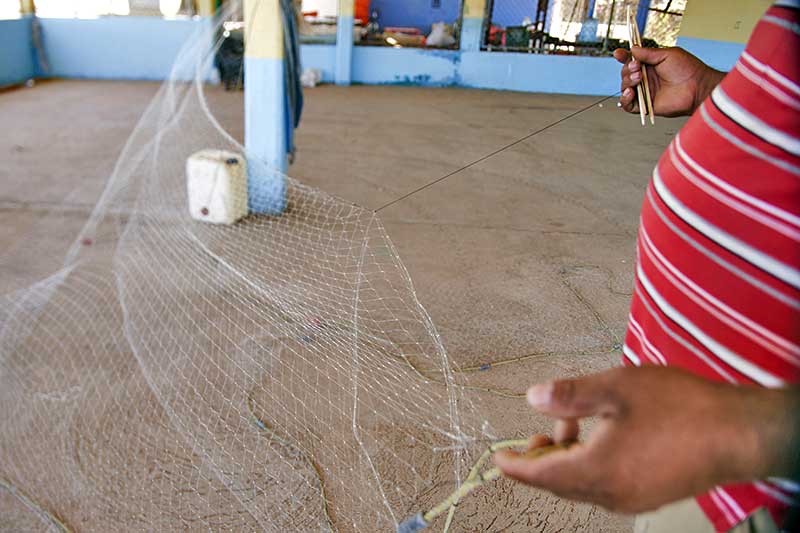
A fisherman from La Reforma patiently mends his nets. The inactivity in Santa María Bay, marked by fishing bans and insecurity, forces many to wait on land before being able to return to sea.
Photo: Eunice Adorno
That same commitment takes him into classrooms. In local elementary schools, Adalberto sits in front of children to share what the sea has taught him. Meanwhile, the women of the cooperative and young volunteers lend their voices to environmental education programs. Gradually, each new generation begins to see the bay not only as a source of livelihood but also as a living territory—one where their future prosperity depends on caring for what gives them life.
Brianta del Pacífico is a reminder that the sea not only provides work—it also teaches. Each tour, each tagged turtle, and each named bird becomes a lesson the community transforms into collective strength. In La Reforma, they know that the future depends not on what is fished or harvested, but on caring for what makes life in the bay possible. And in that constant ebb and flow, among oysters, birds, and turtles, the community has found a germinating idea that keeps it afloat.
From Punta Chueca, on the coast of Sonora, a people once on the brink of extinction have become a beacon—proof that ancestral wisdom, contemporary science, and civic organizations can come together to protect territory and rebuild the bond between the sea and those who live by it.
By Iván Carrillo
The words are unintelligible, but the song is melodious and deep. Valentina Torres Molina keeps it alive as part of a tradition that refuses to vanish. In Punta Chueca, Sonora, the sand blends into the marine horizon and the air scorches the stones. In summer, temperatures climb past 40 degrees Celsius (104 Fahrenheit). On the horizon rises Tiburón Island, Mexico’s largest—Comca’ac territory since before written records existed.
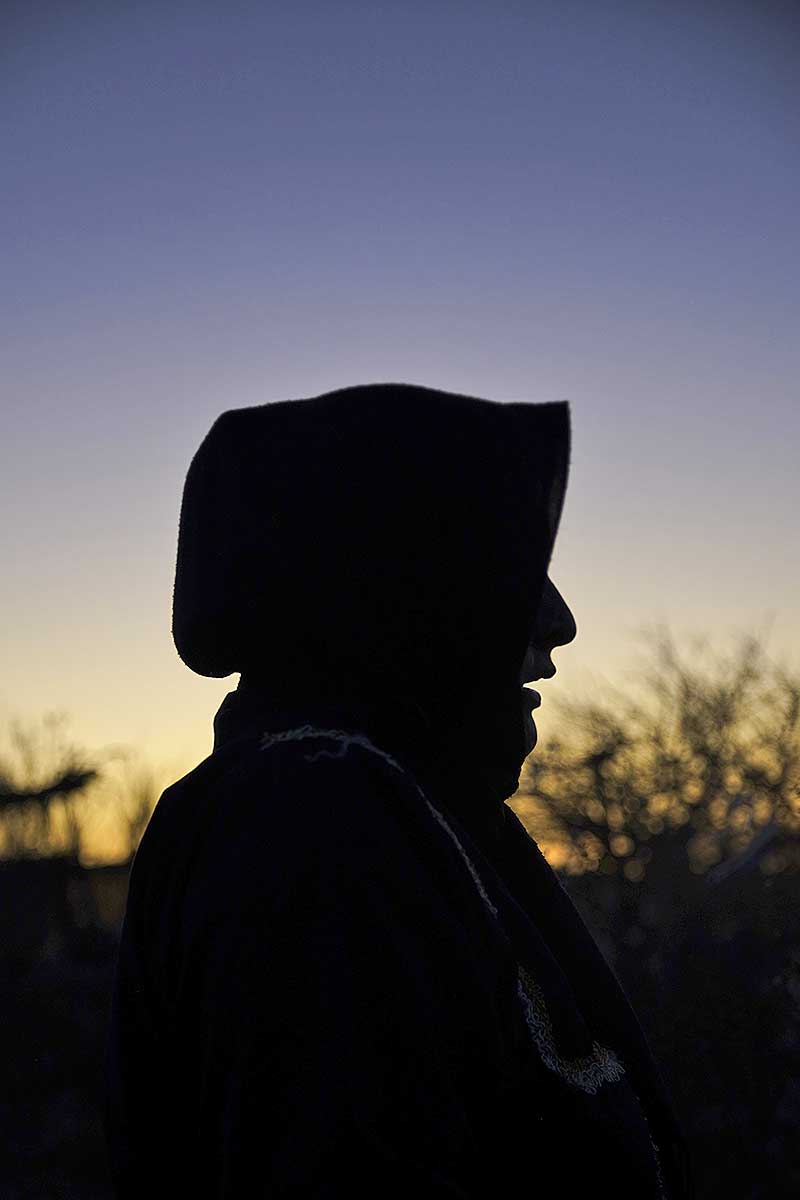
Valentina Torres observes Tiburón Island, the largest in Mexico and part of the Comca'ac community's territory. The island is a geographical and cultural pillar for these people.
Photo: Eunice Adorno
Valentina’s voice carries an ancient rhythm. She narrates the journey of a man who confronts ocean currents and invokes a word to calm the wind and return home safely. The origin of the tale is lost in the distant past of this amphibious people—nomads of the desert, and fishers by fate. Valentina is dressed in black. A veil covers her head. Her dark, serene eyes are fixed and unhurried. She embodies women, resistance, and memory. Her words recall a time when a tsunami turned giants into all living beings that now inhabit the world. That, she says, is where her people’s story begins.
The history of the Comca'ac, or Seri, is shaped by the heat and scarcity of the desert. Their relationship with the territory was not one of dominion, but of understanding. That legacy — their language, songs, herbal medicine, astronomy, knowledge of tides and sea cycles —remains the foundation of their survival today. It is the point where ancestral knowledge meets Western science to reinvent conservation.
But resistance carries a cost. The Comca’ac now face a landscape of threats: collapsed fisheries, unregulated tourism, pollution, language loss, and weakening ties to their territory. Decades of institutional neglect have compounded their poverty and oblivion.
And yet, amid desolation, Valentina’s song endures—her voice linking past and present, reminding us that conservation cannot be imposed by decree.
The Intergovernmental Panel on Climate Change (IPCC) recognizes that indigenous and local knowledge is fundamental for climate change adaptation and resilient development. This principle resonates in conservation initiatives that merge science with the inherited wisdom of coastal communities—placing people at the heart of environmental management.
Punta Chueca could become part of this movement. Efforts to integrate Comca'ac knowledge with modern science point toward the same horizon that inspires the concept of Marine Prosperity Areas: territories where conservation becomes a tool for development.
"We have been conservationists before we knew it," says Aaron Asael Barnett, a young community leader. “Our grandparents were already naturalists who, without realizing it, practiced the philosophy of taking only what was necessary.”
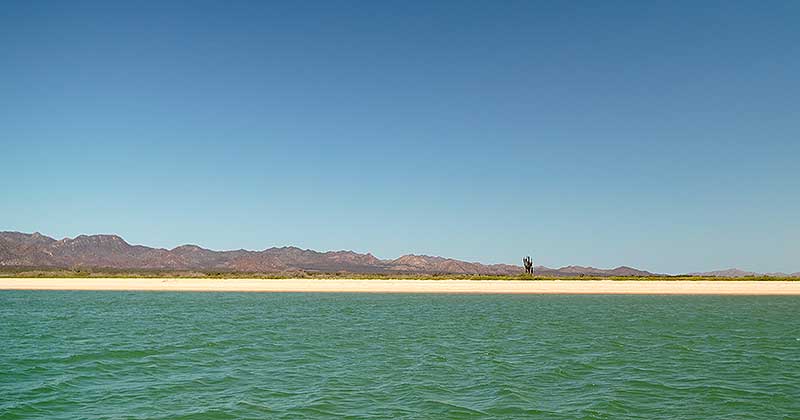
The desert landscape meets the sea in Comca'ac territory, illustrating the uniqueness of this "amphibious people" whose culture has been forged between both ecosystems.
Photo: Iván Carrillo
The Comca'ac history is one of resistance. Since the arrival of Europeans, evangelizing the Indigenous population proved impossible: between 1678 and 1772, missions were established only to be abandoned or destroyed. The Seri, as they were then called, rejected sedentarism, agriculture, and livestock farming—practices alien to their culture and difficult to sustain in an arid desert.
The colonial and the 19th century were merciless: epidemics, military campaigns, deportations, and miscegenation decimated the population until, in the 20th century, only a small group—the remnants of the original communities—continued to defend their cultural autonomy.
Luis Moreno, a sociologist and coordinator of the Indigenous Community Collaboration Program at Prescott College’s Bahía Kino Center for Cultural and Ecological Studies, puts it succinctly: “Their resistance stems from a profound understanding of the environment, of history, and of the past, passed down by ancestors and grandparents.” Comca’ac leaders confirm this, seeing themselves as guardians of an ancient lineage where the ancestral and the Western are not opposed but complementary, walking the same path.

A Comca'ac community leader displays the lines symbolically drawn on the face during the New Year celebrations, the Haaco Camaast. This ancestral ritual connects the community with its cultural heritage.
Photo: Iván Carrillo
This vision of continuity between tradition and modernity became the foundation for projects that would emerge later.
The memory forged through centuries of adversity has been renewed in the face of new threats. The Comca’ac live in constant tension between the past they protect and the present that presses upon them. Waters that once sustained life for generations are running dry. Fishermen in the Canal del Infiernillo say with resignation that each year they catch less, and with greater effort. The once-abundant crab fishery has collapsed, and overexploitation has disrupted the ecosystem's balance.
Illegal fishing and poaching have further undermined their efforts to maintain control. Within the community’s exclusive fishing zone, outside boats operate freely, and abandoned nets, waste in the mangroves, and trash-clogged estuaries attest to insufficient vigilance. As Humberto Romero, one of the community leaders, warns, “Poaching quickly destroys populations—on land and under the sea alike.”
To this, a harsher truth is added: Comca’ac territory, like many regions of Mexico, has been swept by waves of violence, drug trafficking, and conflict with industrial fishing fleets—scenarios where survival demands both resistance and prudence.
And climate change exacerbates everything. Shifts in water temperature, pollution, and biodiversity loss are undermining the very foundations of subsistence. Yet perhaps the deepest wound lies in memory. The rapid loss of language and traditional knowledge threatens to sever the threads that bind generations. Elders fear that if young people stop learning the names of species and reading the tides, the very way of understanding and caring for their world will also be lost.

Fishing is the central economic pillar for the indigenous Comca'ac in Punta Chueca, generating family and community income. Their direct subsistence and local/regional trade depend on the capture of species such as purple snail, pen shell, shark, chano, crab, shrimp, sierra, and other scaled fish.
Photo: Eunice Adorno
Global figures reveal the scale of the crisis: current extinction rates are 114 times higher than the historical natural rate for vertebrates, even by the most conservative estimates. Fish stocks continue to decline—unsustainable exploitation has risen from 10% in 1974 to 35.4% in 2019—a process of depletion that advances in step with cultural erosion.
Science has proven that biological and linguistic diversity are deeply intertwined. According to the 2015 study Endangered Languages by Rogers and Campbell, one language now vanishes every three or four months. Of the planet’s 6,901 living languages, more than 3,100 are endangered. Each lost language erases a unique way of naming and understanding nature.
In the past 500 years, at least 73 genera of vertebrates have gone extinct—a process that, under natural conditions, would have taken roughly 18,000 years.
In recent decades, resistance has evolved into awareness and organization. The ecological crisis of the Canal del Infiernillo is no longer seen as an external threat but as an internal fracture. “The shift in mindset comes from the people themselves, as they witness changes in the environment where they work,” explains Gregory Smart, Assistant Director of Operations at Prescott College’s Bahía Kino Center for Cultural and Ecological Studies.
Fishermen were the first to witness this transformation. But ecological strain was not the only warning sign; the elders began to notice something even more profound—the fading of ancestral knowledge. Their fear that young people would cease recognizing plants, winds, or stars marked the beginning of a new chapter led by a generation raised on desert stories yet fluent in the language of science.
“I feel proud and deeply committed to helping our community and our territory find ways to keep protecting—to preserve part of our culture and ancestral knowledge,” says Aaron.
Such transformations do not happen overnight. Lorayne Meltzer, Executive Director of Prescott College’s Bahía Kino Center for Cultural and Ecological Studies, has witnessed it firsthand for over two decades. Sitting in her office—a space filled with images of the region’s biodiversity and the programs she leads—she recalls that the community “always had the gift, knew where it wanted to go, had the knowledge, but lacked the impetus to put it into practice, to connect traditional knowledge with action.”
That is where institutions play a crucial role, Meltzer insists, noting that truly sustainable processes “are not built in months, but over decades.” And that, she adds, is precisely what has unfolded in Punta Chueca: a community that has moved from resistance to action without losing its essence. One example is the Biocultural School—a learning experience that bridges generations.
The Biocultural School was founded in 1998, led by cultural ecologist Laura Monti, ethnobiologist Gary Nabhan, and a group of community elders including Nacho Barnett. “Originally, it was a project for ecologists,” Lorayne recalls, “where wise mentors—community elders—worked side by side with biologists and Western experts.”
Its goal was to unite traditional and scientific knowledge to protect the territory from a cultural perspective using modern tools. Over time, this vision took root among younger generations. “I’ve learned to combine monitoring techniques for fish, mollusks, turtles, birds, plants, and geology with the traditional knowledge I received from my elders,” says Aaron.
What happens in this biocultural school is unique. Classes include walks through the desert to identify plants, trips to the Canal del Infiernillo to study currents and wildlife, field data collection, and oral storytelling sessions. Mentors such as Humberto Romero teach botany, René Montaño transmits stories, astronomy, and language, and Valentina Torres Molina preserves traditional songs and crafts. It is a pedagogy in which learning is intertwined with the territory.
“You have to treat the mountains, the plants, and the sea as if they were part of your own being,” says Montaño. Romero sums it up in one idea: “The species must be the boss, not the people.”

René Montaño, a Comca'ac leader and expert in botany and astronomy, teaches classes at the Biocultural School. This project integrates ancestral knowledge with contemporary science for territorial conservation.
Photo: Iván Carrillo
The results are visible. The Biocultural School began training a new generation of conservationists to monitor birds, turtles, and plants. Furthermore, it has contributed to preserving their language and stories. In its most recent program, the classroom brought together 30 children and young people, who joined the Punta Chueca Turtle Group on field expeditions, recording 27 sea turtles in the Canal del Infiernillo.
Among those accompanying this process is Crisol Méndez Medina, Assistant Director of Conservation Programs at the Prescott Center. With deep, clear eyes, she has devoted her life to understanding the dynamics of fishing communities and demonstrating that collaboration and organization emerge from the shared work of many actors. For her, the goal is not to idealize communities but to support them through institutions that help build solid and sustainable structures.
“The community is the foundation and the key ingredient,” she explains, “but it needs the accompaniment of other actors—academia, NGOs, and government—capable of providing data, managing laws, and consolidating protection tools.”

Alissa López Barnett, a young Comca'ac, works with sanitation and ecological groups in her community. Her connection to Tiburón Island, the largest island in Mexico (1,208 km²), is significant; the Seris have managed this sacred and culturally important territory in coordination with federal authorities since its declaration as a Biosphere Reserve and Flora and Fauna Protection Area in 1963.
Photo: Eunice Adorno
These programs have demonstrated that conservation is not a discourse but a practice—something that can be counted, weighed, and measured. During the 2023–2024 season, this collaboration resulted in 13 community projects involving over 150 community members. Planning was rigorous: six workshops with 72 community members helped define management priorities for the Canal del Infiernillo Ramsar Site.
The new generation has learned to merge the wisdom of the wind with monitoring protocols, the song of birds with scientific datasheets, and memory with measurement. Today, they know when a mollusk needs to rest and when it can be harvested—and how tides and seasons intertwine with the rhythms of species.
Other initiatives are also unfolding across the region. The Punta Chueca Turtle Group, for instance, conducted eight monitoring expeditions with 27 turtle sightings in the Canal del Infiernillo. Meanwhile, Coijaac, another local group, completed 52 aquatic bird censuses in estuaries and channels, blending the observations of elders with modern biological tools.
In Bahía de Kino, the recovery of Laguna La Cruz—a Ramsar Site crucial to the balance of the coastal ecosystem—continues thanks to the voluntary and organized efforts a group of fishermen with a renewed ecological awareness. In recent years, 11 community projects focused on managing and protecting the wetland have been implemented. Among them, Padres Unidos stands out: a group that has carried out 24 coastal and shoreline cleanups to safeguard the lagoon and foster environmental awareness.
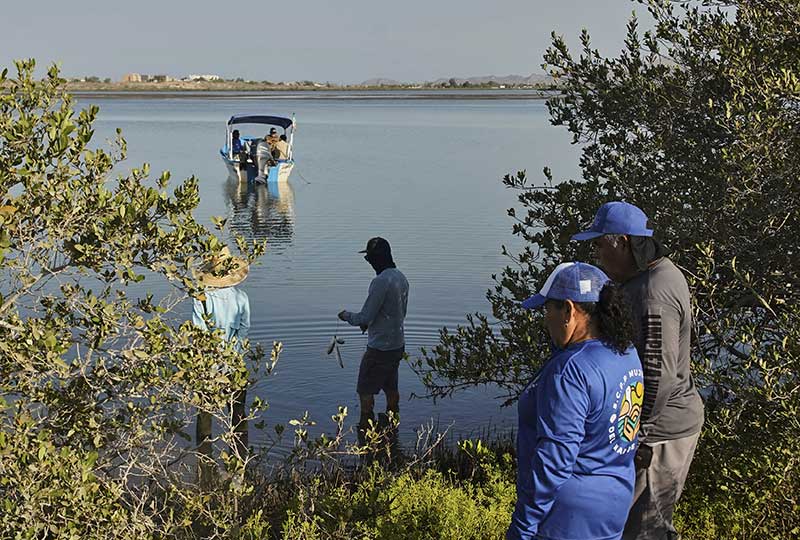
Members of Padres Unidos de Bahía Kino visit La Cruz Lagoon, a Ramsar wetland essential for the reproduction of birds, fish, and invertebrates, many of which are of commercial importance. This community group is dedicated to the conservation of the lagoon and its surroundings, focusing on the protection of marine biodiversity and the surrounding desert vegetation.
Photo: Eunice Adorno
In 2016, the study “The Importance of Indigenous Knowledge in Curbing the Loss of Language and Biodiversity” was published in the journal BioScience. It was not a desk study, but a chronicle born of collaboration between scientists and desert connoisseurs. The Comca’ac case exemplified how ancestral knowledge can be both precise and vast.
For the first time, Cmiique Iitom terminology—the language of the Comca’ac—was placed on equal footing with Linnaean nomenclature. Young “paraecologists” and elders participated as co-authors, writing science in two alphabets: academic and ancestral. Place names such as Tosni Iti Ihiiquet (“where the pelicans have their offspring”) for Isla Rasa, confirmed by 19th-century records, demonstrated the accuracy of Indigenous knowledge—even when bird colonies have since vanished.
In other instances, the Comca’ac perspective guided unexpected discoveries: wild populations of tepary beans (haap) in remote corners of Tiburón Island, or wintering groups of sea turtles once believed to migrate beyond the region.
This knowledge has now been cataloged: 291 Comca’ac names for plants and 264 for mollusks. The study also recovered the symbolic value of storytelling. Songs about marine creatures and mythological reptiles—narrated by mentors like René Montaño, and the melodies that Valentina Torres associates with each species—form part of a living fabric where biology and spirituality intertwine.
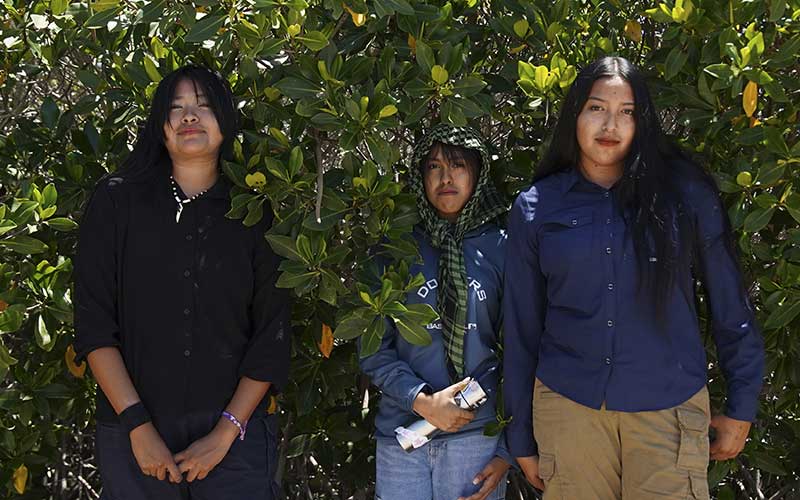
Helen López Barnett, Yaritza Torres, and Alissa López Barnett are young Comca'ac who actively engage with ecological programs in their community. Their participation is fundamental for preserving and consolidating new environmental knowledge, integrating it with the ancestral wisdom passed down by their elders, thus ensuring the cultural and ecological continuity of their people.
Photo: Eunice Adorno
Traditional knowledge not only complements but often precedes science. This was the case with the divergence of spiny iguanas between islands, a fact long intuited by the Comca’ac and later confirmed through genetic analysis. Even when stories and scientific data diverge—as in the case of the bighorn sheep of Tiburón Island, whose oral histories trace their presence 1,500 years ago, unlike the official theory of their 1975 introduction—the result is not a contradiction, but a new question.
The article concludes with a warning that now reads like a prophecy: “The loss of Indigenous languages is equivalent to the loss of entire libraries of ecological knowledge.”
In the 1930s, the Comca’ac were on the verge of disappearance—their population had dwindled to barely 200 people. Today, nearly a century later, they are just over 1,000. This demographic recovery has gone hand in hand with a process of cultural reaffirmation and territorial protection. In 1975, a presidential decree formally recognized the communal property of Tiburón Island and the Canal del Infiernillo, establishing the island’s coastline as an exclusive fishing zone.
Shortly after, the Reserve and Refuge Zone for Migratory Birds and Wildlife of the Gulf of California Islands was established.
In the 1990s, Tiburón Island and the Desemboque ejido were registered as Environmental Management Units (UMAs) by Mexico’s Secretariat of Environment and Natural Resources. This registration underscored the bighorn sheep conservation program, which operates through regulated hunting practices with permits that can cost up to $90,000 per specimen.
More recently, the protected area of the Gulf of California Islands was reclassified as a Flora and Fauna Protection Area by the National Commission of Natural Protected Areas (Conanp). And in 2009, the Canal del Infiernillo Wetland and the estuaries within the Comca’ac territory were designated as a Ramsar Site.
Between decrees, certifications, and protection categories, the territory has accumulated legal recognitions that support what its celebrations and rituals proclaim each year: that its bond with the land and the sea is as ancient as it is enduring.
Every June 30th, when the sun seems to stand still on the horizon and the landscape falls silent under the heat, Punta Chueca and Desemboque celebrate Haaco camaast, the Comca’ac New Year. It is an ancestral ritual where women wear multicolored dresses, men carry amulets, and their faces are painted with colored lines across the cheekbones. The air fills with the scent of turtle soup—whose consumption is permitted here by ancestral tradition—and the sweetness of pitaya wine, made from a fruit that ripens precisely in this season.

A group of Comca'ac women, dressed in their ceremonial attire, participate in the celebration of Haaco Camaast, the Comca'ac New Year. This ancestral ritual, celebrated every June 30th, reaffirms the cultural and spiritual bond of the people with their territory and traditions.
Photo: Iván Carrillo
The songs are transmitted through modern loudspeakers. The voices of elder women drift across the desert and the sea. At the same time, visitors from Hermosillo or Tucson listen intently, seeking to reconnect their urban lives with a spirituality that seems never to have been extinguished.
As night falls, the wind rises from the Canal del Infiernillo, and the voices dissolve into the air. Now the rock band Hamac Caziim (“Divine Fire”) takes over the soundscape with pounding drums, distorted guitar chords, and original verses in Cmiique Iitom. The atmosphere evokes a living culture adapting to modern times without abandoning tradition. Then Valentina’s song returns to my memory—both ancient and present—telling of a man’s journey battling the currents to return home. A metaphor for this people who have learned to row against oblivion, to summon the word, and to return, again and again, to their origin.

Ribbons with the colors of the Comca'ac (Seri) nation's flag—red, white, and blue—are displayed as part of the Haaco Camaast celebration, the Comca'ac New Year. Red symbolizes strength and courage; white, purity and spirituality; and blue, the sea and the sky. Celebrated between June 30th and July 1st, this event marks the arrival of the first rains in the Sonoran Desert and a natural cycle of abundance. The afternoon included dances, songs, and rituals of gratitude and community strengthening by the sea, honoring the cyclical time of the desert and Comca'ac cultural autonomy.
Photo: Eunice Adorno
A collective of twelve women in Baja California Sur has turned environmental defense into a model of self-management and empowerment—confronting stigmas and reclaiming a vital ecosystem through ecotourism, oyster farming, and mangrove restoration. Their struggle for the sea is also a battle for their voice and their future.
By Aminetth Sánchez
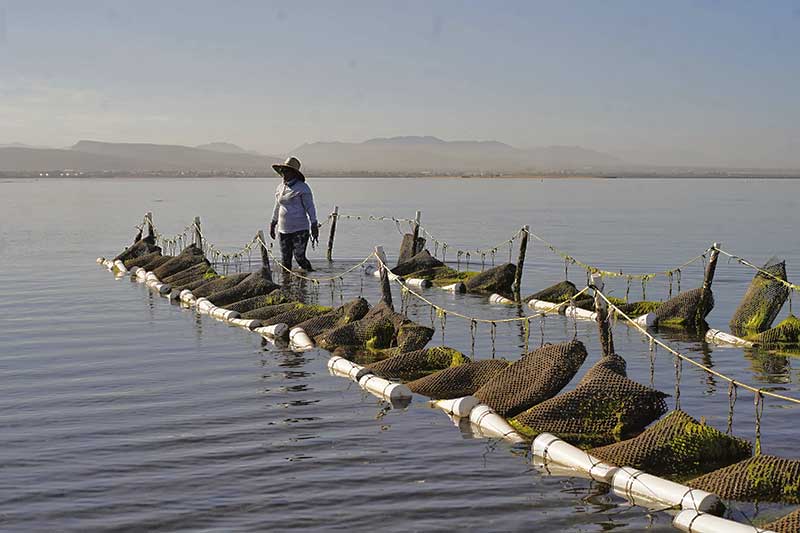
Aracely Méndez is part of Guardianas del Conchalito, a women’s cooperative dedicated to protecting the mangrove ecosystem. They monitor and report illegal logging, poaching, and the dumping of waste in the estuary. The collective also cultivates oysters in hanging lantern cages, where the mollusks feed on natural nutrients while helping to clean the ecosystem. This sustainable practice allows them to generate local income and care for their environment.
Photo: Eunice Adorno
—"Oh, honey, it's her baby!"—shouts Martha García Juárez.
The panga stops. A few meters away, a dolphin slowly moves forward with a dead calf clinging to its snout. For two days, the mother has dragged the small body without letting go. Another dolphin—probably the male—swims beside her. The calf is beginning to decompose, but the mother insists on carrying it. The cause of death remains unknown.
In the boat, Martha and Araceli Méndez Márquez watch in silence. Both belong to the Guardianas del Conchalito, a collective of twelve women who monitor the estuary, clear channels to restore mangroves, manage the state’s first nursery, cultivate oysters, and lead ecotourism tours in La Paz, Baja California Sur. They are defenders of their territory and lovers of the sea, convinced that caring for it means caring for themselves and their community.
They wonder whether to intervene. Martha answers without taking her eyes off the water:
“She’s saying goodbye.” The scene occurs at Nayarit beach. What was supposed to be a routine trip to the oyster farm becomes an unexpected interlude—a quiet reminder of life and death in the sea they have learned to protect.
At first, no one took them seriously. The sea, people said, was men’s work. Women were welcome on the pangas—but not to make decisions.
For years, they worked within those limits. They accompanied the men, fished, sold the catch, and filleted the fish—nothing more.
“It was normal for us to be on the pangas,” says Martha, general coordinator of the Guardianas. “I used to handle the sales. Yes, we killed, yes, we filleted—but when we started to become partners, that’s when the problems began.”
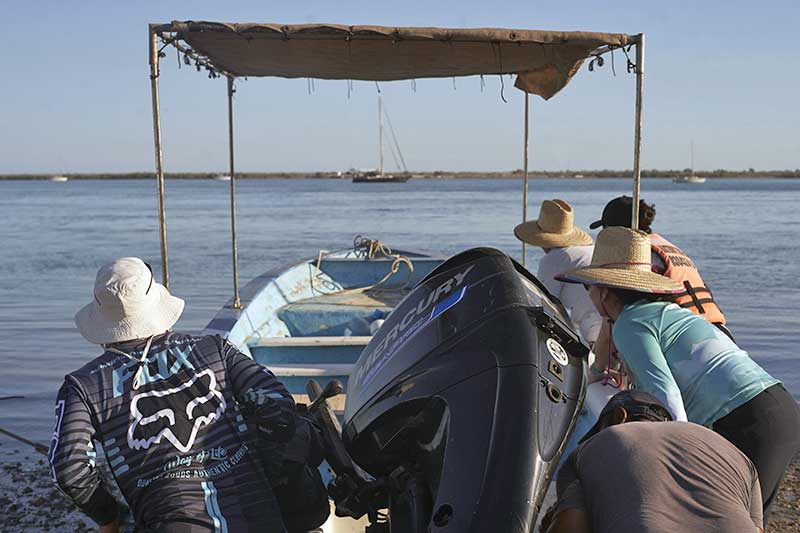
Members of Guardianas del Conchalito, a collective that has restored 70% of the estuary’s mangrove forest, prepare their boat for a workday.
Photo: Eunice Adorno
That “problem” began when five new positions opened in the Organization of Fishermen Rescuing the Ensenada (OPRE)—a local initiative formed by the community of El Manglito to restore and manage the Ensenada de La Paz sustainably—and they were given to women.
It was their first formal entry as partners. What looked like recognition quickly turned into a fight for legitimacy. They held positions, attended meetings, signed minutes—yet still couldn’t make decisions. “We weren’t heard,” Martha recalls. “We were on the board, we had official roles, and still, our voices didn’t count.” The exclusion became a form of daily violence. More than one considered walking away.
At the same time, another front emerged—one that would change everything: the El Conchalito estuary. Illegal scallop fishing was concentrated there, and that’s why the women decided to act. In 2017, they began patrolling the area—first under OPRE, and later as an independent collective.
Their first task was surveillance: daily rounds to stop illegal extraction in a site already damaged by siltation and looting. Their presence was unsettling. Seeing women in authority was, for many, unacceptable.“There were taunts, shouts, insults,” recalls Rosa María Gil, coordinator of the Guardianas’ nursery. “They would yell: ‘Bring your husband! Go wash the dishes! What are you doing here?’”
It wasn’t just verbal hostility; the area was marked by violence and neglect.
“It was scary to be here. It was dark, desolate. A lot of palomilla—fishermen—would come into the mangroves to use drugs. We confronted many illegal operators,” recalls Rosa María Gil, better known in El Manglito as Doña Rosa.

Martha Magdalena García Juárez, president of the Guardianas del Conchalito cooperative, leads monitoring and reporting efforts against illegal logging, poaching, and waste dumping in the estuary.
Photo: Eunice Adorno
The Guardianas stayed despite the fear, convinced that their presence itself was a form of defense. And that persistence began to change everything. “Because we were here, Conanp (the National Commission of Natural Protected Areas) noticed us. Now we co-manage the area and keep it clean,” says Doña Rosa.
What began as an uncomfortable task eventually opened the door for them to be recognized as legitimate actors in the defense and restoration of the estuary.
The work was arduous—and transformative. Doña Rosa states it clearly:
“Before, I was very submissive. I did what my husband said; I didn’t know my worth. Now, no—I’m equal to anyone. Before, my children would laugh and say we were just going to play bingo. Now they see us on Facebook and say, ‘That’s my mom. I’m proud.’”
Martha sums it up with the same conviction: “I am Martha. I’m not Juanito’s wife or Andrea’s mother. I’m Martha. No one speaks for us anymore. We learned to believe in ourselves—and that was the hardest part.”
The estuary stopped being a place of plunder. Illegal fishing waned, and with it, the notion that women were meant to watch from the sidelines. The Guardianas rediscovered themselves as protagonists—women capable of monitoring, deciding, and sustaining a territory that had long been denied to them.
Water returns where it can. Sometimes it needs someone to open a vein for it. In El Conchalito, the Guardianas and a group of young volunteers dig into the earth with picks and shovels so the sea can breathe again. Daniela Bareño, 35, puts on her hat. “Let’s go to the channels,” she says. She is the group’s tourism and environmental education coordinator—she walks fast, talks just as quickly. With one hand, she traces the estuary’s map in the air.
“With pick and shovel,” she repeats proudly, because heavy machinery is forbidden in the area.
This place was once called Estero San Martín. Now it’s El Conchalito, named after the shell mounds left by its earliest inhabitants. In the 1980s, a dense mangrove forest thrived on the tides. Seawater flowed through natural channels, keeping the soil moist, oxygenating roots, and feeding life. Today, only 30% remains. The other 70% died, smothered by silt and urban waste that blocked the tidal veins.
“When it rains in the city, everything—mud, trash—flows downhill into the sea,” Daniela explains. “These tidal veins got blocked, the water stopped circulating, and the mangroves died. The soil turns hard, like cement.”
Before picking up tools, the Guardianas sought advice from Costasalvaje and Leonardo Moroyoqui Rojo, a biologist specializing in mangrove restoration at the Humedales Sustentables organization. His diagnosis: eleven tidal channels within the polygon were clogged. With that report, they obtained permits from Conanp to reopen up to one kilometer of channels—manually. “We didn’t know anything about permits before,” Martha laughs. “Now we write our own official letters; we know what to ask for and how to ask for it.” They started in April. So far, they’ve opened 90 of the thousand authorized.

A hydrological channel restored by Guardianas del Conchalito in Baja California Sur. The collective reforests the estuary by reopening channels and managing nurseries for red, black, and white mangroves, while monitoring their growth. The ecosystem is home to three of the four protected mangrove species, as well as numerous bird and crustacean species.
Photo: Eunice Adorno
The first channel has its birth certificate nailed to a wooden post. Hand-painted letters read:
‘First Hydrological Channel – April 23, 2024’. Below are the names of its creators: Guardianas del Conchalito, Costasalvaje, and Conanp. Behind it, a narrow ditch glistens with moisture. When the tide rises, it becomes a stream. The water enters as if remembering home—soaking roots, darkening the soil.
“Something so simple, and it changed everything,” Daniela says. “Now the tide reaches areas that were once dry. We’re seeing more marine life—shrimp, fish, crabs—things we hadn’t seen this close in years.” She walks across the wet, slippery soil—a living symbol of restoration. Nearby, stakes mark a new beginning: the thick-billed plover has started nesting again.
The first channel has already received maintenance; it needs it annually. At low tide, the water looks murky, but the system moves and brings treasures: crabs, glasswort (a genus of succulent plants that grow in salt flats), and mangrove seedlings. Daniela explains the technical aspects: "We take measurements with hoses to determine levels. If the water stagnates inside, it becomes salty and useless. We have to give it a slope so the tide can enter and exit." This first channel is 46 meters long, 70 centimeters deep, and 1.5 meters wide.

One of the “veins” reopened by Guardianas del Conchalito shows the flow of water returning to the ecosystem. Restoring water circulation has brought life back to the estuary, fostering biodiversity and the growth of local flora and fauna.
Photo: Eunice Adorno
Further ahead lies the second channel, opened in 2025. Daniela points at a dark line of moist soil. “The tide now reaches here. See that wet edge? It used to be all dust.”
Everything is the result of the Guardianas and the young volunteers. For what’s left to open, the plan remains the same: work alongside the young volunteers, this time in the El Mogote area, where they’re preparing a new one-kilometer channel. They handle the permits, logistics, and schedules—and when the time comes, they get in the mud too.
There are no lounge chairs or all-inclusive resorts here. Nor do they sell postcards or souvenirs. Here, tourists are put to work.
“Tourism in Baja is usually about appreciation — visiting a landscape, being on the beach, enjoying its beauty. But here, we want to put you to work, to make you feel useful, to leave your mark, your grain of sand as you pass through — to come, clean, conserve, and carry that message to new generations about how to care. So it’s a totally different kind of tourism,” Daniela explains. “Ours is ecotourism — focused on education.”
The Guardianas welcome groups and organize tours that begin with a simple invitation: “Let’s go to the estuary.” The goal is not to watch from afar, but to understand with one’s hands. Ecotourism, they say, is focused on education.
The tour starts in the nursery. Doña Rosa teaches where to plant and where not to — mangroves aren’t planted randomly. Then comes the estuary: bird-watching, understanding the hydrological channels and their purpose. There, they explain why the channels were opened, where they were blocked, and what caused the tide to recede.
Then comes the mud — not for a photo, but for work. Cleaning, digging, learning the rhythm of the shovel. The Guardianas visit an area where small mangroves grow naturally, keeping the site clear and returning water to it. They also visit the section where they cultivate oysters.
It is not appreciative tourism; it is not just going to the beach. Visitors leave a mark: they collect, conserve, and carry the message onward. “This year, 200 young people have joined the Guardianas tour, always with the idea that they can protect, care for, and understand the importance of these ecosystems — and that those of us who visit them can also help preserve them,” Daniela says. That lesson stays with them.
The heart of the tour is also the heart of the organization: the mangrove nursery — the first in all of Baja California Sur. It was established in 2023 with support from Costa Salvaje, and since then, four Guardianas have cared for it daily. One of them is Doña Rosa, who, at 64, smiles as she says: “I’m the nursery coordinator. They call these my children, because every mangrove I see grow fills me with pride.”
The routine is sacred yet simple: watering every third day, mixing soil with fresh and saltwater, compost, and leaf litter. The first planting was all trial and error, but experience turned them into skilled caretakers.
“At first, we watered them only with fresh water, and they started drying up. Andrea — Martha’s daughter — told us we had to add saltwater once a week, and look how beautiful they are now,” Rosa says, stroking a green stem.

The mangrove ecosystem under the care of Guardianas del Conchalito. Its restoration has been achieved through simple, community-adapted techniques developed by the collective.
Photo: Eunice Adorno
In the nursery, red, white, and black mangrove seedlings coexist — all grown from seeds collected in the same estuary that was once on the brink of death. Their goal is to repopulate the areas where up to 70% of the mangrove was lost to trash, chemicals, and siltation. The seedlings stay in the nursery until their stems are strong enough to withstand sun and tide; then they are transplanted to restoration zones. “You have to keep adding saltwater, remove the shade so it adapts to the sun, and then plant it,” Rosa explains.
Each season, they repeat the cycle: collect seeds, cultivate them in the nursery, and then replant them in the restoration zone. With each planting, the objective is to expand coverage and ensure that the estuary regains the dense mangrove forest that characterized it. "This is just beginning," Rosa says. "What we see small today will be a forest tomorrow that protects the community."

Mangrove seedlings in the nursery of Guardianas del Conchalito. The collective learned to use a mix of fresh and salt water for irrigation—a technique that has allowed these young plants to thrive.
Photo: Eunice Adorno
The water barely reaches Chelis’s ankles as she bends over the sacks where oysters grow. She lifts one, shakes it, flips it, and sets it back down. The movement is part of maintenance: turning the sacks allows the mollusks to dry in the sun and the algae to detach. At first, the Guardianas del Conchalito hesitated to take on the project. “I had already worked in oyster farming with OPRE — with the men. I was the only woman there. When the Guardianas were offered the project, we didn’t want to accept because it seemed like too much work. We thought we couldn’t do it,” she recalls. But they went ahead — and in May 2024, they harvested their first crop.
The process takes time: six to eight months when starting from spat (seed oysters), or four months with juveniles. Each bag holds about 120 oysters, which reach different sizes depending on the season. Restaurants in La Paz often request smaller oysters, six to seven centimeters, while others prefer larger ones. Today, they sell a dozen for 150 pesos.
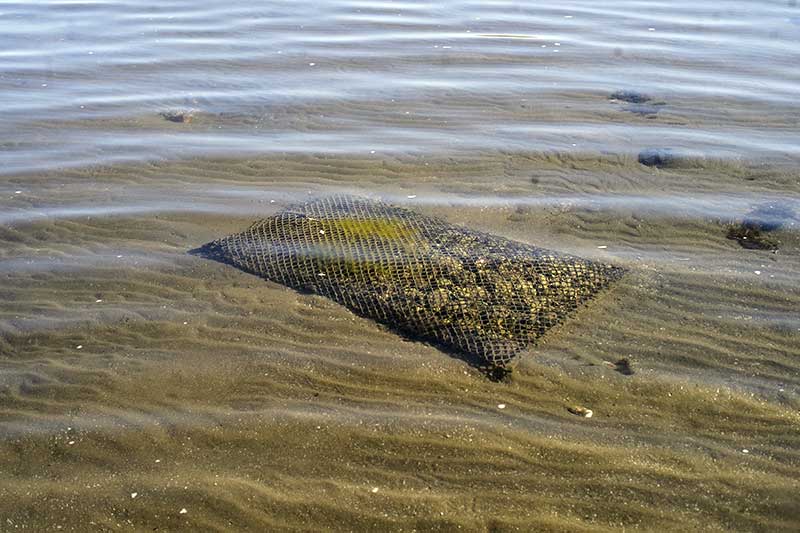
Oyster cultivation is one of Guardianas del Conchalito’s strategies for economic diversification and sustainability, developed in the waters of the estuary.
Photo: Eunice Adorno
It wasn’t all smooth sailing. To establish their cultivation area — more than 20 minutes from Nayarit Beach — they had to negotiate with OPRE, where some members opposed women occupying that space. “Yes, they put obstacles in our way, because where we are now belongs to OPRE. We had to hold an assembly with all the members to get permission,” Araceli recalls.
They also lacked their own boat, relying on relatives for transport. And the technical learning curve was steep. “When an oyster grew a small shell, we thought it was ruined. But in a sanitation course they told us it was just a tiny clam looking for a home — not harmful, the product was still good,” she laughs.
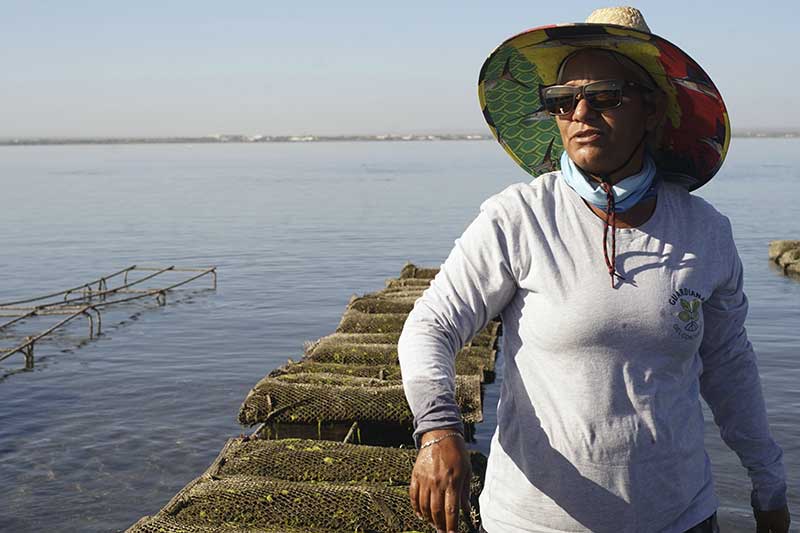
A member of Guardianas del Conchalito works on oyster cultivation—a project that initially sparked doubts within the collective. Today, after their first harvest in May 2024, it represents both economic diversification and autonomy.
Photo: Eunice Adorno
Production is still modest but growing. The Guardianas plan to reinvest their earnings in buying new spat and expanding cultivation. Their next goal: create a youth-run cultivation area — not for mass production, but to show visitors during tours. “We want people to see what we do, to get in the water with us, and to learn,” says Chelis.
Today, they no longer depend on borrowed spaces. After negotiations with Conanp and the fishing delegate, they secured an aquaculture permit right where they work. The concession now belongs to the Guardianas.
The Guardianas soon realized they couldn’t rely only on fishing or external aid. They had to diversify. In addition to oyster farming, they began cooking and selling fish tacos, drinks, and snacks at local events. Ecotourism became another source of income — not beaches and postcards, but mud, shovels, and open channels. Today, their tours include visits to the nursery, channel cleaning, and oyster tastings by the shore.
The logic is simple: more income sources mean less pressure on the sea.
Their role has also expanded to defending their territory. In the El Manglito neighborhood, they’ve faced projects that threatened the coast: a residential development seeking to privatize the beach with a private dock, and a boutique hotel that blocked access to a channel with fences. They didn’t remain silent. They attended assemblies, signed petitions, and lobbied until they regained access. In their words, the principle is clear: the sea cannot be privatized.
This learning also influenced their relationship with organizations. They acknowledge the importance of those who have supported them, such as Costa Salvaje, Mama Cash, and Fondo Semillas, among others, but they do not want to depend on them. Now they manage their own resources and decide how to invest them. "It's comfortable to depend on others, but it's not healthy. We want to be self-managed," Martha insists.
This independence is also reflected in their critical stance. They oppose projects they consider a setback, such as "Espíritu te necesita" (Espíritu Needs You). "Because it goes against the fishermen. For generations, they have harassed us with no-fishing zones, and now they want to disguise it in another way. No," Martha says firmly.

Amid the oyster fields, a Guardiana del Conchalito stands as a symbol of the resilience of the women who have overcome obstacles. Their work embodies autonomy and the promise of a sustainable future.
Photo: Eunice Adorno
She sums up their philosophy in one sentence: “Fishermen wither when they become employees. Freedom is what defines us.”
Their pursuit of autonomy has made them a community reference point. Neighbors turn to them for help with electricity bills, or with health and housing paperwork. Meetings with state authorities are held at Martha’s home. What began as surveillance became leadership.
“We live day to day, just making it to the end of the month. We never plan for the future. How can you imagine life 30 years from now? It makes no sense — as if you weren’t living,” Martha says.
For the Guardianas, time is measured in tides and oyster harvests — in channels that breathe again, in seedlings striving to grow. The rest will be left to those who come after them. What they do know is that their example is already taking root.
At the northern tip, fishermen like Alfonso Valenzuela are adopting ancestral and sustainable techniques to protect the vaquita—the planet’s most endangered cetacean— proving that conservation and a decent income can go hand in hand, despite market resistance and ongoing challenges.
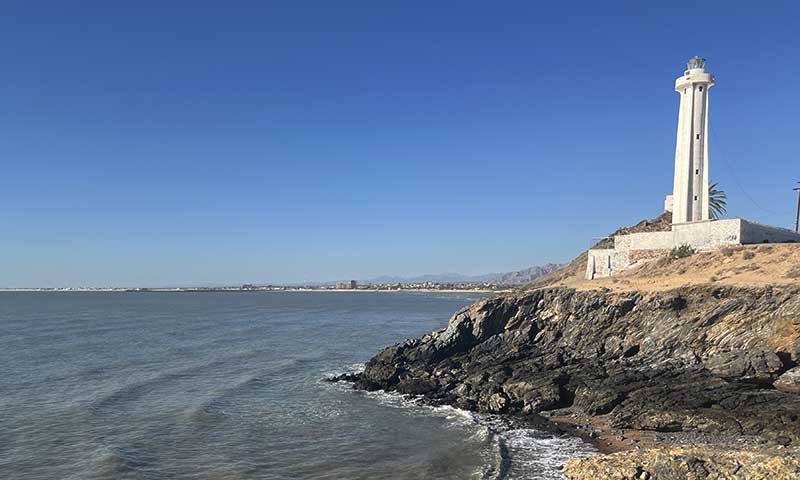
The coast of San Felipe stretches along the Upper Gulf of California, a meeting point between the desert and the sea. This region, rich in biodiversity and with a deep fishing tradition, currently faces the challenge of balancing development with the conservation of its fragile ecosystem.
Photo: Víctor R. Rodríguez
By Víctor R. Rodríguez
A hot wind blows from the jaws of the Baja Californian desert, heralding a relentless, crushing summer. Alfonso Valenzuela – Poncho to everyone – prepares to go fishing in San Felipe, a port nestled in the Upper Gulf of California. He won't use nets. He decided to return to the old method —line and hook —so as not to entangle the vaquita, the planet's most endangered cetacean. If the sea is on his side, he will return with just enough for a dignified income.
"When we first arrived here, there was abundance, there was everything. But little by little, it’s become scarce because of all the nets in the water,” Poncho says, his gaze fixed on the sea that has watched him grow old.
Nets promise more volume, but piles of fish don’t always mean more income. With line and hook, the story changes: the volume drops, but every kilo of Gulf corvina —a species found only in this corner of the world— fetches a better price. Poncho chose this path when he joined a sustainable fishing program for conservation purposes, launched in 2022 by the organizations Pesca ABC and Pronatura Noroeste. There, he learned techniques like Ike Jime, a Japanese method that preserves fish quality and boosts its market value.
This shift has placed Poncho and other fishermen at the heart of an unavoidable tension. In the Upper Gulf of California, the livelihood of hundreds of families coexists with the urgent need to protect species on the brink of extinction. To go fishing here is to walk a tightrope —to survive without compromising the future.
The Upper Gulf of California is one of Mexico’s most productive fishing regions. According to the Mexican Institute for Research in Sustainable Fisheries and Aquaculture (IMIPAS), the main fisheries include Gulf corvina, caught from March to October; chano and sierra in April; and traditional shrimp fishing between September and November. Together, these fisheries generate around 72.4 million pesos each year.
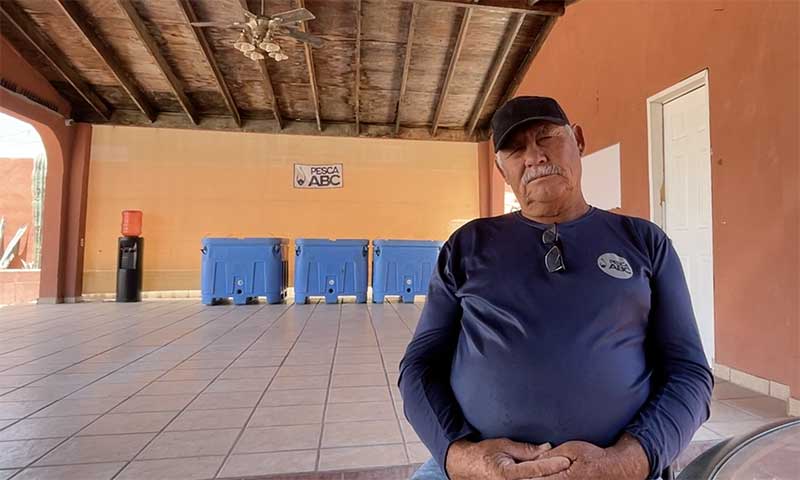
Interview with Alfonso Valenzuela, a fisherman from San Felipe, who shares his experience and commitment to sustainable fishing techniques in the Upper Gulf of California.
Photo: Víctor R. Rodríguez
Alongside its productivity, the Upper Gulf is also one of Mexico’s most monitored and regulated seas. Here, conservation happens at the edge of possibility: traditional fisheries share the same waters as the vaquita, Mexico’s most vulnerable marine mammal. Scientific monitoring that began in 1997 paints a stark picture: from 567 vaquitas in the 1990s, the population fell to just nine in 2018—a 95% decline. The most recent estimate, from 2024, suggests that only six to eight specimens remain in these waters.
Bound by constitutional duty and international pressure, the Mexican government has been striving for years to transition toward fishing gear that doesn’t doom the porpoise to extinction. It’s an uphill process, but one with a clear horizon: the creation of a Marine Prosperity Area.
Poncho doesn’t sail alone. Beside him is 60-year-old José Ernesto Martínez—known as Malacara—another San Felipe fisherman who also joined the sustainable fishing program, which currently includes only 20 participants.
Malacara casts his line and waits. Patience is part of the trade. Suddenly, a pull—there’s movement on the other end. With a confident motion, he lifts the fish from the water and passes it to Poncho. Poncho takes his knife and, with a precise thrust, ends its life swiftly and cleanly, just as the Ike Jime technique prescribes.
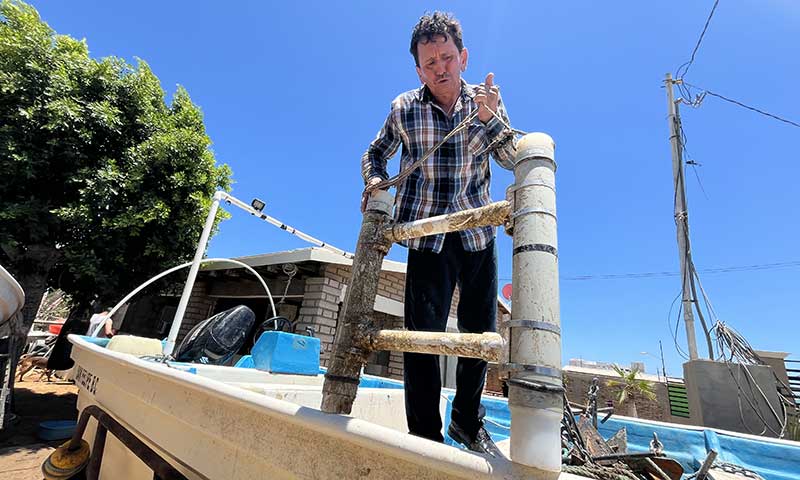
A fisherman checks his C-POD (Cetacean Detector) equipment aboard his vessel in the Upper Gulf of California. These acoustic devices are crucial for monitoring the vaquita and other marine species.
Photo: Víctor R. Rodríguez
The sustainable fishing program, funded by international sources, was launched in 2022 with one basic principle: stay close to the community. Listen, and let fishermen envision their own future—how to fish differently, and how to make conservation more than a political or scientific slogan. This collective effort, this co-design, forms the first pillar of the Marine Prosperity Area (MPpAs): community participation.
Training soon became central. For the first time, fishermen saw themselves not as recipients of orders but as part of the strategy. Workshops, meetings, and hands-on practice in new techniques contributed to the second pillar: capacity building. Training stopped being a promise and became a daily practice.
Progress also relies on private initiative. El Sargazo, a seafood company based in Ensenada, Baja California, rewards sustainability by paying up to 3.2 times more per kilo when the fish carries the traceability mark, the hook, and the Ike Jime seal. Less volume, yes—but greater value.
“As long as there is demand for products caught with hooks, processed with Ike Jime, and carrying traceability, more pangas will join the effort in the Upper Gulf,” says Pesca ABC's science coordinator for fisheries, Georgina Proal.
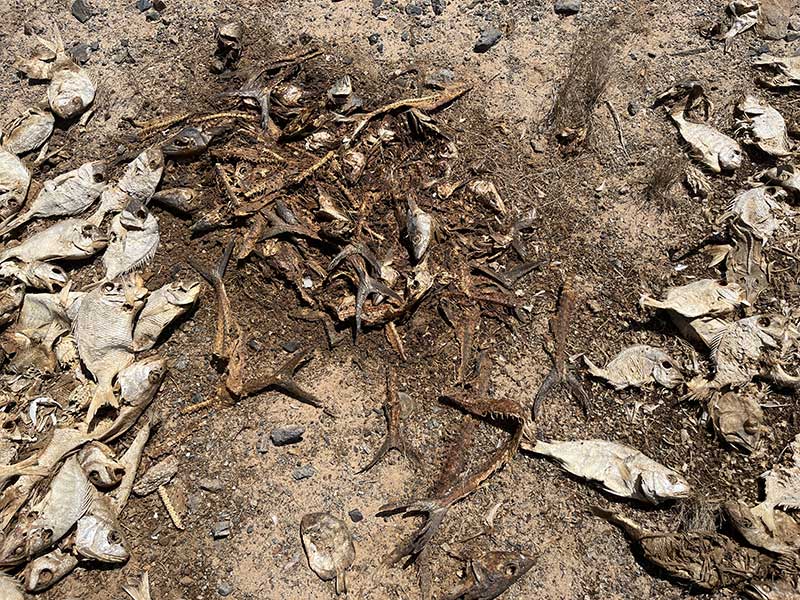
The harsh reality of an illegal fishing dump, where dried and dead fish highlight the devastating impact of illegal practices on marine resources and ecosystem health.
Photo: Víctor R. Rodríguez
Poncho and Malacara know this well. They don't just fish; they are also part of the network that seeks to save the vaquita. Supported by scientists, local fishermen set sail and, guided by GPS coordinates, deploy hydrophones to collect data and clearly delineate the vaquita's proper habitat. These mapped data allow experts and the Mexican government to adjust the species' conservation strategy.
With hydrophones in the water and El Sargazo rewarding traceable catches, glimpses of the MPpAs’s third pillar—monitoring and co-management—begin to emerge. But it’s still just a sketch. A formal governance system, sustainable infrastructure, and broader community participation are still needed. For now, what exists are the first signs of a potential Marine Prosperity Area.
Earning more by fishing without nets and supporting conservation sounds like the perfect formula. But the reality is different: Poncho and Malacara are exceptions. Only 20 men participate in this program, out of a registry of 1,738 active fishermen in San Felipe, Baja California, as of 2024, according to the National Commission of Aquaculture and Fisheries (Conapesca). The numbers speak for themselves.
The market for fish caught with sustainable techniques, for now, remains stagnant. Two out of twenty, twenty out of thousands—a drop in the ocean.
In San Felipe, 1,738 people make their living from fishing, yet only about twenty have adopted sustainable techniques. The market for such products remains limited, and orders are scarce, discouraging other fishermen from joining the conservation effort in the Upper Gulf of California. The slowdown isn’t up to them or their partner organizations—but it affects both their wallets and their morale. “The product is here,” says Poncho. “It’s just a matter of getting it into the markets.”
In summer, legal fishing goes on pause. Fishermen call this period el piojo—“the louse”—months of waiting and resisting until the next season. Like Poncho, those enrolled in the sustainable fishing program remain steadfast, convinced that fishing differently is the way to recover the sea of abundance they once knew.

While fishermen like Poncho endure "the louse" (piojo) of the closed season with sustainable gear, this illegal net dump in the Upper Gulf starkly contrasts with their vision of an abundant sea, serving as a reminder of persistent threats and the urgent need for responsible fishing.
Photo: Víctor R. Rodríguez
After the devastation caused by Hurricane Roslyn, the Nayarit community of Boca del Camichín is rising again, guided by the strength of the Marismas Nacionales and the San Pedro River, forging a model of sustainable development and collective resilience. For its people, defending the ecosystem is defending their own lives.
By Raquel Zapién Osuna
En octubre de 2022, el huracán Roslyn puso a prueba la capacidad de resistencia y adaptación de la comunidad de Boca del Camichín. De las 500 balsas flotantes utilizadas para el cultivo de ostiones entre los manglares y las lagunas costeras de las Marismas Nacionales de Nayarit, no quedó casi nada. La magnitud de la pérdida fue devastadora, pero la respuesta comunitaria demostró una resiliencia ejemplar.
In October 2022, Hurricane Roslyn tested the resilience and adaptability of the Boca del Camichín community. Of the 500 floating rafts used for oyster cultivation among the mangroves and coastal lagoons of Nayarit's Marismas Nacionales, almost nothing remained. The magnitude of the loss was devastating, but the community's response demonstrated exemplary resilience.
Three years later, the landscape has changed: 430 artisanal wooden rafts once again float on the water, safeguarding this year's oyster production thanks to the collective effort of the 163 members of the Ostricamichin Cooperative, including nearly 40 women.

In the coastal landscape of Boca del Camichín, a fishing boat and oyster shells reflect the community's oyster farming activities. This environment, part of the Marismas Nacionales and fed by the San Pedro River, is fundamental for the sustainable development and resilience of its inhabitants.
Photo: Cruz Morales
In October 2025, the community took another step forward by establishing its first community risk management brigade. The initiative promotes a culture of prevention against future storms and hurricanes—events that are expected to become more frequent and intense as the climate crisis deepens. This proactive approach is crucial in such a vulnerable region and sets an important precedent for other coastal communities.
But meteorological phenomena have not been the only challenge for this coastal town in the municipality of Santiago Ixcuintla, Nayarit. Here, people have had to organize to maintain their primary source of income, which involves protecting the mangrove forests and the San Pedro Mezquital River basin, the last free-flowing river in the Sierra Madre Occidental. Its fresh waters keep the marshes alive—an ecosystem vital to Mexico’s Pacific coast.
This community's story of resilience has deep roots. In the 1970s, when oyster beds collapsed due to overexploitation, the General and Aquaculture Fishing Production Cooperative Society Ostricamichin was formed as part of a federal government program. Fishermen, initially skeptical, eventually joined when they saw that wild production was no longer sufficient, recalls Óscar Guadalupe Padilla Angulo, president of the cooperative and son of Eleuterio Padilla Tapia, a founding member. This turning point is key to understanding the community's transformation towards sustainable management.
Today, in Estero Grande, Boca del Camichín—where river and sea converge—production reaches between 800 and 1,000 tons per year. Most oysters are sent to Guadalajara before being distributed to other parts of the region.
Cultivating the native oyster (Crassostrea corteziensis) provides work for eight months of the year, while shrimp, scale fish, shark, and prawn fishing supplement the income of this community of over 1,300 inhabitants.
“Many of us no longer fish full time; we focus on harvesting and maintaining the oyster beds,” says the cooperative leader. “Few dedicate themselves entirely to fishing, but the impact on fisheries is minimal.”
Nearly everyone in the community is linked to oyster farming or related activities—preparing cultivation ropes, collecting, packing, or selling. Women, children, youth, and elders from the famous "oyster capital" participate in these processes.
“It’s a family endeavor; children start helping with the ropes from a very young age,” explains Heidy Zaith Orozco Fernández, executive director of the Center for Social Development and Sustainability Nuiwari, a civil association that has supported the community in defending its territory and strengthening its organization.
This biocultural bond with nature has made Boca del Camichín one of the main bastions in the defense of the river and the marshes—where ecological restoration has gone hand in hand with social and economic development.
The most emblematic struggle was against the Las Cruces hydroelectric project, promoted by the Federal Electricity Commission (CFE), whose Environmental Impact Statement was authorized by the Ministry of Environment and Natural Resources in 2014. This conflict is a paradigmatic example of the tension between economic development and environmental conservation in Mexico.
Protests by citizen organizations, fishing and rural communities, and the Náayeri and Wixárika indigenous peoples temporarily halted the project. And although studies demonstrating its unviability have been presented, the threat persists because the plan has not been discarded and is intended to be resumed under the name of Presa del Nayar.

A native oyster (Crassostrea corteziensis) in the foreground — a cornerstone species for the sustenance of Boca del Camichín. Its cultivation is vital to the Ostricamichín Cooperative, which has built a model of adaptation and resilience within Nayarit’s coastal ecosystem.
Photo: Cruz Morales
The Ostricamichín cooperative remains on alert. Its members attend informational meetings promoting the project and participate actively in public consultations.
“Every time they call a consultation, we go to defend ourselves and make it clear that we disagree,” says Óscar Padilla.
In Boca del Camichín, there is a collective will. “It’s something essential,” Padilla adds. “We must take care of our environment—it’s where we live, what feeds us, what lets us survive. And besides, it’s a wonderful place.”
The community has forged alliances to strengthen its capacities and leadership. The Nuiwari civil association has been key in this process. It emerged during the defense of the San Pedro River and, although initially focused on defense, today its strategies are aimed at strengthening community structures to face their difficulties, explains Heidy Orozco.
One of the most recent achievements was the formalization, in October, of the first community risk management brigade, which will develop an action plan outlining what to do before, during, and after the arrival of a hydrometeorological phenomenon. The formation of this brigade is a concrete step towards community autonomy and self-management in emergencies.

Ostricultores de Boca del Camichín cosechan en Estero Grande, donde la mezcla de agua dulce del río San Pedro y salada del mar crea un entorno óptimo. Esta labor, esencial para la economía local, es un pilar de la gestión sostenible en las Marismas Nacionales.
Photo: Cruz Morales
At the request of local women, the community has also begun preventive work with children to reduce the risk of future addictions. Their first step was to form the children’s club Los Ostiones (“The Oysters”), where kids learn about their rights, the environment, and how to prepare emergency backpacks.
Another strategic project is the inclusion and recognition of women in the fishing sector. Empowering women and children is essential for the long-term sustainability of the community’s project.
As part of that effort, in April 2025, the women of Boca del Camichín hosted the First Meeting of Riverine and Sea Women, welcoming fisherwomen from across northwest Mexico to reflect on women’s often-unpaid and unacknowledged role in the value chain. On October 11, they hosted another gathering that led to the creation of the Network of Riverine and Sea Women of Nayarit.
The establishment of this network represents a significant advance in the visibility and recognition of women's work in the regional fishing sector. According to recent research by Xavier Basurto, published in Nature, four out of ten fishers worldwide are women. They can be part of the family business—wives, mothers, daughters—or simply women from the community hired to do the work. Currently, with the support of WWF and Nuiwari, efforts are being made to strengthen the cooperative's processes and promote the inclusion of women.

Children in Boca del Camichín take part in workshops organized by Los Ostiones (“The Oysters”) club, promoting environmental awareness and knowledge of their rights. The initiative aims to empower new generations to protect and care for their natural surroundings, including the Marismas Nacionales and the San Pedro River.
Photo: Cruz Morales
All these actions complement the ongoing surveillance, cleanup, and conservation work carried out by local families in coordination with the National Commission of Natural Protected Areas (Conanp), which manages the Marismas Nacionales Nayarit Biosphere Reserve. This protected area covers 133,854 hectares and contains nearly 20% of Mexico’s mangroves, making it a Ramsar wetland of global significance across five municipalities. Its protection is essential for biodiversity and climate mitigation.
Meanwhile, life in Boca del Camichín flows between the oysters cultivated in the marshes and those served to visitors—fresh, in tamales, soups, or empanadas—who come to savor the place’s cuisine and ecotourism activities.

An oyster farmer from the Ostricamichín Cooperative explains the cultivation process in Boca del Camichín. Their expertise preserves artisanal techniques and a deep connection to an activity that has enabled the community to rebuild and adapt to change, keeping its oyster-farming tradition alive.
Photo: Cruz Morales
The Ostricamichín Cooperative hopes to establish an oyster-smoking plant to add value to their production and create jobs for young people. The project was close to becoming a reality when Hurricane Roslyn struck, destroying more than 90% of the harvest and damaging facilities, forcing a halt. Its eventual completion could become a key economic engine, diversifying income and ensuring the participation of new generations.
To recover, the cooperative members returned to artisanal fishing, restarted cultivation, and began rebuilding with their own savings after funds ran out.
"We thought we wouldn't recover," recalls the cooperative's president. But they did.
An innovative model led by Mexican scientists seeks to turn marine conservation into a catalyst for social well-being. The challenges are many, yet the success of a small coastal community in Baja California Sur stands as a beacon of inspiration.

Sunrise over Santa María Bay, Sinaloa. Photo: Ramón Eduardo Hernández Montoya
The road to Cabo Pulmo winds between desert and sea. From La Paz, Baja California Sur, the highway cuts through low hills and towering saguaros. In the distance, mirages shimmer—promising water where there is only parched earth. Even the soundscape feels arid: tires crunching, stones clattering, dust stirred by the wind. Then the asphalt gives way to dirt. At times, the sea flickers into view, a blue line trembling between land and sky.
In the truck, Octavio Aburto rides in the passenger seat. He lets the wind hit his face and smiles softly as he draws closer to his destination. He’s been taking this road for over two decades—the same amount of time he’s spent studying the reefs and watching them come back to life. He’s welcomed by young guides who learned to dive back when he was still figuring out how to measure marine life. For many here, Aburto isn’t just the scientist who documented the reef’s recovery; he’s part of the story that made it possible.
A marine biologist and photographer, he has dedicated his life to tracing the heartbeat of the Gulf of California. Few know its paradise as intimately—or its scars as deeply. Through his lens, Cabo Pulmo comes alive in a dance of abundance and motion: moray eels tucked among violet corals, flashes of multicolored fish gliding past anemones, and spirals of jackfish moving as one—like a single, silvery, mythic creature. His research confirms what his images reveal, a story often cited in conservation forums as an example of what’s possible: in this corner of the sea, life returned.
It wasn’t a miracle, but the result of collective effort—proof that ecological restoration and social well-being can move forward together. Today, as the Gulf of California faces an environmental crisis, what happened in this small reef at the southern tip of the peninsula stands as the foundation for a new approach to marine management: the Marine Prosperity Areas (MPpAs).
After nearly three decades without fishing in Cabo Pulmo, marine biomass increased by 463%, according to Scripps Institution of Oceanography. The reef, once on the verge of collapse, is now a global benchmark for ecological recovery.
Photo: Octavio Aburto
In the mid-1990s, when fishermen began hauling in empty nets, they made an unthinkable decision: to stop fishing and give the sea a second chance. It was a leap of faith with no guarantees— “fishing was the only thing we knew how to do,” says Judith Castro, a member of the Castro family, Cabo Pulmo’s founders.
But the sacrifice paid off. Today, the community thrives on diving, sustainable tourism, and other local services, welcoming some 40,000 visitors each year drawn to the reef. That generates roughly $8 million in annual revenue for a population of just over 200 people.
Photos shared on social media by thousands of divers capture the reef’s abundance, home to more than 300 fish species. Bull, tiger, and hammerhead sharks patrol its waters; rays glide across the horizon; five of the world’s seven sea turtle species come here to nest. In winter, humpback whales show their tails before continuing their journey. Everything moves, everything seems to breathe.
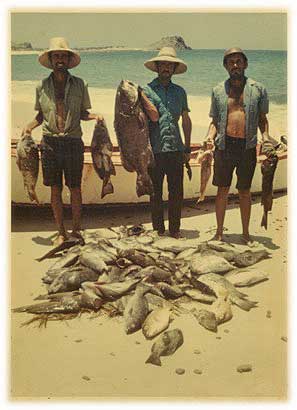

The Castro family, founders of Cabo Pulmo, pictured in a time when the sea provided everything. Decades later, they would lead a historic transformation: giving up fishing to save the reef.
Photo: Courtesy of Judith Castro
Science proves it. In 2009, after ten years of monitoring, Octavio Aburto and his team confirmed that the reef's biomass had increased by 463%.
Unfortunately, Cabo Pulmo shines alone.
Once called "the world's aquarium," the Gulf of California still provides between 40% and 70% of Mexico's fish but shows clear signs of depletion. Scientific literature warns that most of its fisheries are fully exploited or at risk of overexploitation, with key species like sharks, shrimp, red snapper, and mahi-mahi under unsustainable extractive pressure.
The crisis is exacerbated by species displacement —sardines, for example, are beginning to leave the Gulf for the Pacific as sea temperatures have risen by up to 1°C over the past decade— and by the disappearance of large predators that once kept ecosystems in balance. Today, biomass is concentrated at the lowest levels of the food chain, a phenomenon known as "fishing down the food web," revealing how a sea once brimming with life has been emptied of its essence.
Marine ecologist Fabio Favoretto, drawing on 25 years of observations since the 1998–1999 baseline, confirms this. Preliminary results from his latest monitoring, conducted in summer 2025, report that in key areas such as Loreto and La Paz, fish populations have nearly halved. "While a healthy ecosystem should maintain around four tons of fish per hectare," he warns, "today we barely record between one and one and a half tons."

Recent scientific monitoring in the Gulf of California reveals a former sargassum forest now colonized by coral. This illustrates the accelerated tropicalization of the ecosystem due to climate change.
Photo: Fabio Favoretto
The deterioration of the Gulf of California goes far beyond environmental concerns. "Nature's degradation leads to social degradation," warns Alejandro Robles, director of Noroeste Sustentable, “because it fails to generate wealth, and community economies suffer.”
Beyond Cabo Pulmo and its tourist centers, the Gulf reveals a mosaic of fishing villages teetering on the edge of subsistence. Here, artisanal fishing —the sole livelihood for thousands of families — faces a double-edged sword: necessary regulations to protect ecosystems also reduce job opportunities and heighten economic insecurity. Added to this is the historical exclusion of fishermen from decision-making processes; their voices are often marginalized in the management of protected areas, fostering mistrust and resistance.
With few economic alternatives and inadequate basic services, many communities live in a state of uncertainty and resignation. Uncontrolled tourism, disputes over land and sea access, and a lack of infrastructure only deepen their vulnerability.
The causes? Environmental historian Micheline Cariño, professor and researcher at the Autonomous University of Baja California Sur, summarizes it: "The depletion of the seas is blamed on fishermen, but in reality, we have all contributed: the government, by promoting industrial fishing; companies, by investing more capital; and consumers, by eating fish as if it were farm-raised."

“Fishermen suffer the most—businesses and consumers can adapt, but they lose their livelihood,” says environmental historian Micheline Cariño. A fisherman at his home on the La Paz inlet.
Photo: Iván Carrillo
She concludes: "They are the ones who suffer the most. Consumers change their menu, businesses pursue other ventures, the government extracts something else... but fishermen are left with nothing to live on."
Favoretto starkly summarizes the urgency of the moment: "The choice is not 'we move forward or we protect.' There is no middle ground. It's simple: we either collapse or we protect—and perhaps save ourselves."
By the roadside, Manuel Enrique Castro bids farewell to his clients. He is 39 years old, the son and grandson of fishermen. Nowadays, he runs a dive shop with six boats and a team of ten people. Each year, he serves roughly 1,500 tourists under a strict rule: no more than eighteen divers per shift. "It's not about working for the sake of working," he says, "you have to know how to work, because we are not donkeys."
A few meters away, Adriana Sofía Santa Ana, 27, guides snorkel groups. She studied alternative tourism and sums it up with humor: "Here, we're all jacks-of-all-trades." She has seen orcas, blue whales, leatherback turtles, and even a tiger shark. “Every time you head out, it’s magical—but also fragile.”
The delicate balance sustaining Cabo Pulmo is under strain. Increasing foreign investment seeks to open resorts or tourist facilities. Many locals partner with them to survive, but profits often leave the community. During peak season, some lower prices or relax rules to attract visitors.
These strategies, by the numbers, work. In 2006, the park welcomed 3,600 visitors; by 2019, that number had risen to 26,000. Today, around 40,000 tourists visit each year—a figure that now threatens the ecosystem’s capacity.
From his son’s restaurant, Mario Castro, one of the park’s founders, gazes at the horizon. “We worked so hard, and now they’re selling it to the highest bidder,” he laments. He lost a leg but still coordinates dive trips. His children and grandchildren remain here. “Sometimes I think about leaving, but they don’t want to leave this place,” he admits.

Tourist boats crowd the beach at Cabo Pulmo, Baja California Sur. The boom in ecotourism— attracting more than 40,000 visitors each year—now tests the limits of the ecosystem’s carrying capacity.
Photo: Eunice Adorno
The shoreline keeps retreating. Boats come and go. Prices climb. Tourist developments move forward under the guise of sustainability, while social media paints a picture of a flawless sea. In Cabo Pulmo, the challenge is no longer surviving scarcity—it’s learning how to manage abundance.
“I don’t call it success, because success can be fleeting,” says Judith Castro. “I prefer to call it an example of community-based marine conservation. The day we stop caring for it, that success will vanish. But as long as we keep protecting, educating, and fighting for this place, it will stay alive. And if we manage to help other communities do the same, then all of this will have been worth it.”
Systematically plundered since the last century, the Gulf of California stands today as a reflection of failed public policies, institutional neglect, and—above all—the mistaken belief that it was an inexhaustible resource.
When Micheline Cariño speaks about the Gulf of California, her voice shifts from admiration to outrage. She lives in front of it, watches it every day, studies it as a historian, defends it as an environmentalist, and endures it as a witness to a long history of abuse.
“The plundering of the Gulf of California is devastating,” says the professor and researcher at the Autonomous University of Baja California Sur. “And in the face of dwindling fish stocks, the technoscientific and political response has been: add more technology and take what’s left. It’s an absolute disregard for resilience—a blindness to limits.”
For much of the 20th century, the Gulf of California was seen as a marine Eden—a sanctuary of life teeming with more than 800 fish species, 92 of them endemic, seven sea turtle species, and 40% of the planet's marine mammals.
Yet since colonial times, the region has been treated as a vast storehouse waiting to be emptied. “The sea has always been viewed as a warehouse—a stockpile you could reach into again and again without consequence,” says Cariño, director and co-author of the four-volume Nuestro mar, perhaps the most comprehensive work on the Gulf of California’s environmental history.

And faced with the evidence of declining fish stocks, the techno-scientific and political response has been: add more technology and take what's left. It's an absolute lack of consideration for resilience, a blindness to the limits.”

It is possible that all the reefs in the Gulf of California are already at their minimum biomass and the decline will continue.”

We knew it was a beautiful garden, but we didn't know how important it was.”
Photo: Octavio Aburto
Manta rays swim in the Gulf of California, one of the planet's most biodiverse seas. Its ecosystems host thousands of marine species, from whales and sharks to corals, turtles, and colorful fish.
Photo: Octavio Aburto
The wounds of the Gulf of California have been open for over a century. The first wave of extraction glittered with the deceptive luster of pearls and mother-of-pearl—the “white gold” of the 19th century. With the arrival of mechanized diving suits, oyster beds were exploited to extinction by 1940. Then came sharks, sardines, and shrimp. Each industrial boom left behind a more desolate sea.
"Coastal fishermen took part, but were driven by the market, subsidies, and politics. The whole system was built to extract, not to protect,” Cariño explains.
The result was a bled-out ecosystem. The construction of the Hoover Dam in 1936 in the United States reduced the flow of the Colorado River, altering the dynamics of the Upper Gulf and leading to the collapse of emblematic species like the totoaba and the vaquita, which are also victims of international trafficking. In just five decades, the Gulf's total biomass fell by 60 to 80%, and today, seven out of every ten fisheries are overexploited or on the verge of collapse.

Since the 19th century, the Gulf of California was seen as an inexhaustible resource. Today, it faces an unprecedented crisis: 70% of its fisheries are fully exploited or at risk of collapse.
Photo: Octavio Aburto
Climate change has exacerbated the crisis. Recent studies show that in the past decade, the central Gulf’s water temperature has risen by an average of 1°C—enough to throw an entire ecosystem off balance. Heat alters microscopic plankton, the foundation of marine life, triggering—or already setting off—a chain reaction that ripples through the food web: less food for small fish, fewer small fish for larger ones, and an increasingly silent sea.
Along with the loss of biodiversity, the fishing culture—another source of life in the Gulf of California—is disappearing. “What’s being lost isn’t only biodiversity, but the biocultural heritage of fishing,” says Cariño. “It’s not just a job; it’s a way of life, a culture. An entire identity disappears when fishing resources are destroyed.” It was in this context that the story of Cabo Pulmo began.
Before it became a global model for conservation, Cabo Pulmo was a small fishing village. But by the mid-1980s, a troubling pattern had emerged. “My father and brothers would go fishing and often come back with nothing,” recalls Judith Castro. “They would borrow money for gas and return only with debt.”
The Castro family had been bound to the reef for generations. The grandfather, Jesús Castro Fiol, was among the area’s first pearl divers. When the shells ran out, he became a scale fisherman, and his children inherited that trade. As fish grew scarce, young men like Mario Castro had to venture farther and farther out to sea to find a catch.

Young Judith Castro with a freshly caught hammerhead shark in Cabo Pulmo. Fishing was the community's heart, and Judith later became a founder of the marine park.
Photo: Cortesía Judith Castro
That was when researchers from the Autonomous University of Baja California Sur began visiting the community. They arrived with notebooks and cameras, took samples, talked with fishermen, and warned about the reef’s fragility. “We knew it was a beautiful garden, but we didn’t know how important it was,” says Judith. The bond with scientists grew stronger until, with the support of biologist Gabriela Anaya and professor Óscar Arizpe, the fishermen petitioned the government to create a protected area. On June 6, 1995, the decree establishing Cabo Pulmo National Park was published.
The early years were difficult. Fishing was banned, and no one knew how to do anything else. “Those were very hard years,” Judith recalls. “The closed area covered 7,000 hectares, and the ecosystem hadn’t yet recovered.” Octavio Aburto agrees: “Cabo Pulmo’s beginnings were far from idyllic.The fishermen struggled through the first decade, when everything was forbidden and the reward was not yet visible.”
In time, the sea responded. Corals began to grow again, fish returned, and sharks reappeared. “My dad said we were crazy,” Mario remembers. “But one day I brought him money from diving and told him, ‘It’s yours—from your panga.’ He couldn’t believe it.”
But the biological revival also drew the attention of new predators: the Cabo Cortés tourism project, which proposed thousands of hotel rooms, golf courses, and a marina facing the park. The fight against the development was “a turning point,” says Judith Castro. They called the press, organized talks, sought legal advice, and even traveled to Spain—the project’s country of origin—to defend the reef. Resistance turned into a movement, and the giant was defeated. “That’s when Cabo Pulmo became known around the world,” says Judith. “Everyone wanted to see the reef that had been saved by its own community.”

Marine biologist Octavio Aburto, a professor at Scripps Institution of Oceanography, visiting Cabo Pulmo. His early 2000s research documented the exponential increase in fish biomass after the park's creation.
Photo: Eunice Adorno
What began as a community decision—to stop fishing in order to save the reef—ended up offering an empirical lesson in how ecological and social prosperity can advance together. Octavio Aburto and the team of scientists who accompanied the process realized that this success had to be deeply understood: it needed to be broken down, its components identified, and turned into a model that others could replicate. The central question was: how were local leadership, social cohesion, the practical use of science, and—above all—tangible benefits for people cultivated?
The academic answer lies in Marine Prosperity Areas (MPpAs), a management model designed to understand and recreate, in other regions, the conditions that made Cabo Pulmo possible. A place that, as Aburto describes, managed to move “from theory to practice,” advancing ecological restoration and human well-being in tandem. A success measured in money, yes—but one that transcends economics. “In Cabo Pulmo there is prosperity because there is no vandalism, no prostitution, no alcoholism… There is a stronger, fairer society,” says Aburto.
Cabo Pulmo proved that conservation can also mean prosperity.
Francisco Mejía and Brandon Joya, tourism service providers at Cabo Pulmo beach. Once overfished, this ancient Pacific reef transformed into a model of community-based ecotourism after being designated a National Marine Park in 1995.
Photo: Eunice Adorno
Amid the Gulf of California crisis, scientists have identified 30 priority zones that, while covering just 1% of Mexican waters, could protect 37% of critical habitats and raise local incomes by up to 70%.
It’s no surprise that the idea of prosperity as a starting point for ecological restoration was born in Cabo Pulmo—or, more precisely, in its reef. Diving there is like entering a symphony of life: schools of fish gliding like liquid mirrors, sharks emerging among jackfish, corals pulsing with their own rhythm. For those who have seen the depleted reefs of Cancún or Puerto Vallarta—where the absence of fish has become the landscape—the experience feels like a journey through time: this is what the seas were like before collapse.
Octavio Aburto’s photographs capture this abundance eloquently. Yet if the photographer documented it, the scientist has explained its origins. What makes Cabo Pulmo unique is not only its biodiversity, but also the web of diversities that sustain it—biological, cultural, social, and economic. “Cabo Pulmo showed that the ocean can heal if given time and respect,” Aburto says.
From this experience, scientists have learned that protecting an ecosystem is not enough: the lives that depend on it must also be safeguarded.
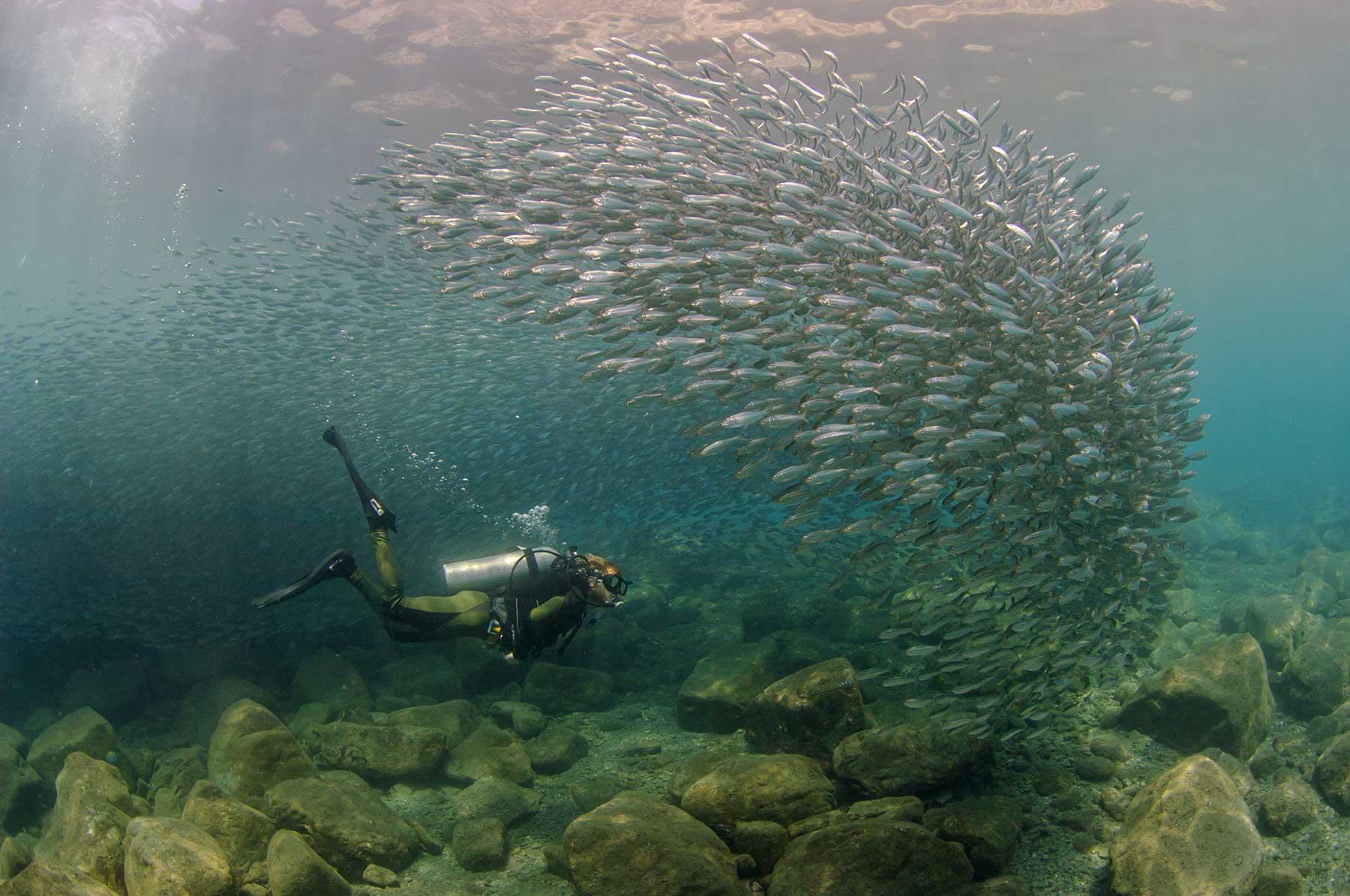
A diver surrounded by a school of jacks in Cabo Pulmo, captured by Octavio Aburto. The image captures the remarkable recovery of marine life and has become a global symbol of community-led conservation.
Using a sort of reverse social engineering, they analyzed the case to understand its mechanisms, its process, and its potential for replication. From that effort emerged the concept of Marine Prosperity Areas (MPpAs), proposing a new scientific framework to reconcile ecological restoration with the economic and social prosperity of coastal communities.
The idea began with a critical realization: for years, it was believed that protecting the sea would automatically improve the lives of those who depend on it. But evidence has shown the opposite. Too many Marine Protected Areas (MPAs) have become mere “paper parks”—declared polygons lacking enforcement, funding, or scientific monitoring, and most importantly, lacking tangible benefits for local communities.
Currently, fewer than 5% of MPAs in Mexico show verifiable ecological recovery. Globally, seven out of ten fail completely or partially. In the Gulf of California, a study on the effectiveness of protected areas found that out of 23,300 km² of reserves, only Cabo Pulmo meets its conservation goals.
Faced with this scenario, the proposal is a conservation model with a human face—one that breaks from the tradition of measuring success solely by tons of fish or hectares protected. Its core metric is socio-ecological prosperity: places where people can live well without depleting their environment. “The goal,” says marine ecologist Fabio Favoretto, “is to build well-being in order to regenerate the sea, not to wait for the sea to regenerate well-being.”
Aerial view of the Gulf of California and the coast of Baja California Sur. From above, the sea looks pristine, but beneath its surface, 70% of fisheries are overexploited, and coastal ecosystems are losing resilience.
Photo: Eunice Adorno

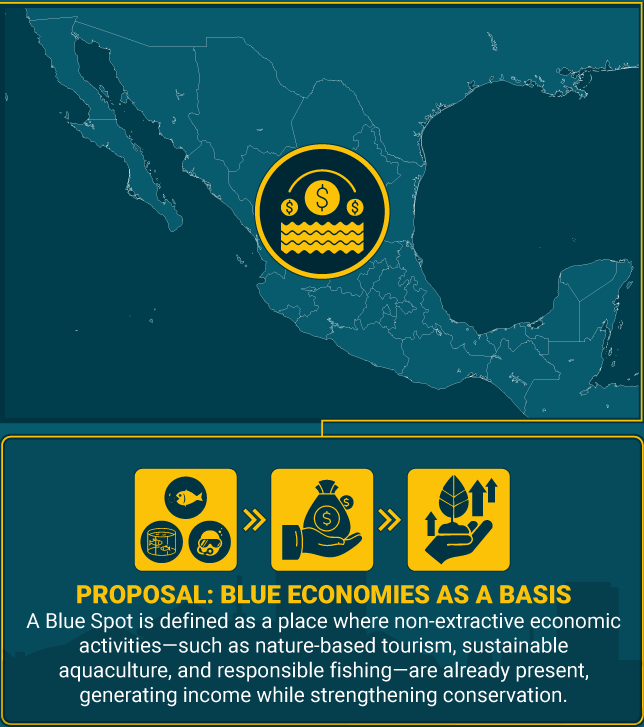
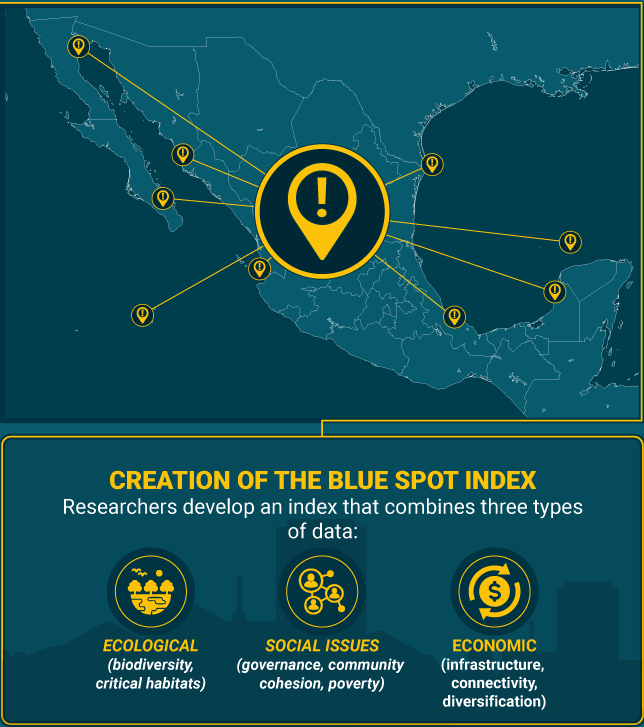
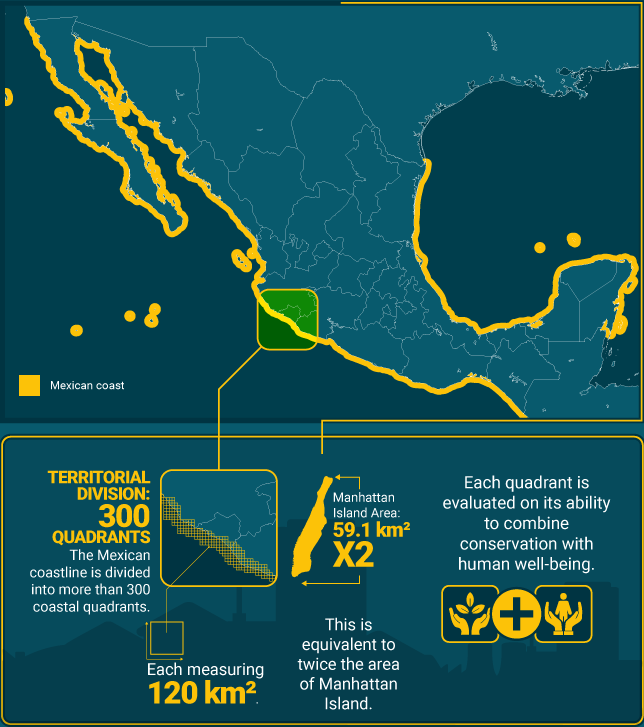


For years, marine conservation focused solely on ecology—on identifying biodiversity “hotspots” where protected areas could be established. But that approach left coastal communities out of the equation. Recognizing this limitation, researchers widened their lens toward “bright spots,” showing that success also depends on local governance and social capacity.
One of the innovative pillars of the MPpAs proposal is the concept of "Blue Spots." This approach integrates biology, governance, and economic viability to identify areas where non-extractive economies—such as diving tourism, wildlife observation, or sustainable aquaculture—already exist, generating income while fostering long-term conservation.
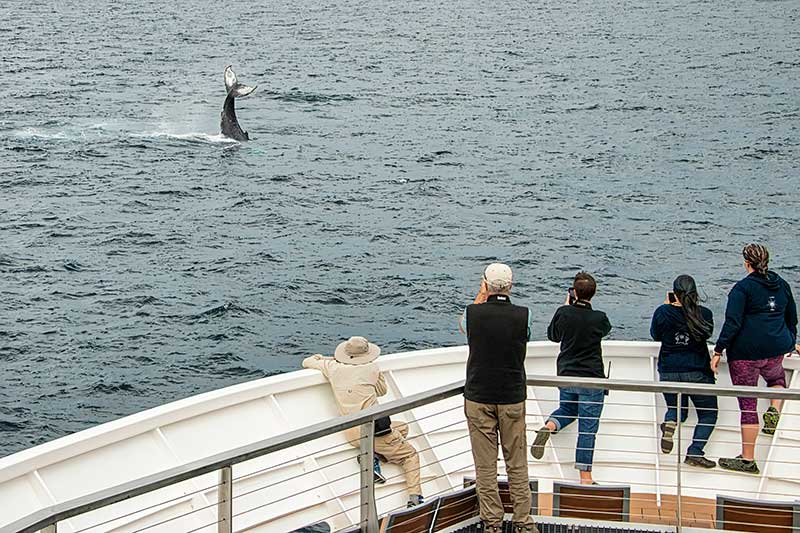
A group of travelers watches a whale surface in the waters of the Gulf of California. Marine wildlife tourism not only offers unforgettable experiences, but could also serve as a vital economic driver for coastal communities, promoting conservation and sustainable development in the region.
Photo: Octavio Aburto
For that reason, one of the researchers’ greatest challenges has been to locate sites with real conditions for a sustainable model based on the nine pillars of MPpAs: community participation, strong governance, social investment, environmental education, monitoring, and more.
To achieve this, scientists created the Blue Spot Index—a tool that analyzes ecological factors (biodiversity, critical habitats), social factors (cohesion, poverty, governance), and economic factors (infrastructure, connectivity, and productive diversification).

José Luis Alameda Álvarez, founder of OPRE, leads marine conservation efforts in El Manglito, La Paz. Since its founding in 2016, his organization has helped boost scallop populations from 60,000 to 3 million by 2015.
Photo: Eunice Adorno
Using this method, Mexico’s coastline was divided into over 300 coastal quadrants, each covering 120 km²—twice the size of Manhattan Island. Within each, the potential to align ecological prosperity with human well-being was evaluated.
The result? An unprecedented map of opportunities for ecological and social development: 30 priority zones covering only 1% of Mexico’s territorial seas, yet capable of protecting up to 37% of its critical habitats—mangroves, seagrass beds, and reefs. These areas could also boost community incomes by more than 70% within a decade through sustainable economic activities such as ecotourism and responsible fishing.
Octavio Aburto, a researcher on the project, sums it up: “Any site in the Gulf of California that achieves good governance and fosters blue economies can reach—or even surpass—the success of Cabo Pulmo, even with fewer ecological resources.”
As the world strives to meet the global 30×30 goal—protecting 30% of the planet by 2030—Cabo Pulmo stands as proof that conservation can also drive human well-being. The next step, says Octavio Aburto, is scaling the experience: “We’re envisioning the creation of ten Marine Prosperity Areas over the next ten years. Those ten areas in the Gulf of California could help a hundred communities spark economic growth and social well-being.”
Yet not everyone shares the same enthusiasm. Environmental historian Micheline Cariño warns that no model can be universally applied: “Each community has its own idiosyncrasies, history, challenges, people, and expectations.” What works in Cabo Pulmo, she adds, won’t necessarily work in La Reforma or El Manglito. Her warning is clear: prosperity cannot be imposed. “Top-down processes,” she says, “impoverish people—humanly and morally.” The only sustainable path is hyperlocal, horizontal, and participatory work grounded in respect and deep knowledge of the territory. “You must know the people, their context, and their history; build trust, and then engage in dialogue to co-design what they truly need.”
Catalina López-Sagástegui, director of the Gulf of California Program at the Institute of the Americas and part of the team promoting MPpAs, agrees that every community defines well-being differently. “What works for Cabo Pulmo doesn’t necessarily work for Punta Abreojos, for example.” While INEGI statistics help measure progress, she stresses the importance of considering the subjective dimension of these indicators. In some communities, development might mean a new pier or paved streets; in others, like Cabo Pulmo, keeping the environment intact is part of well-being. “Both are valid,” she says, “because prosperity isn’t imposed—it’s built from what each community values.”

Aracely Méndez, a Guardiana del Conchalito in Baja California Sur, works within her cooperative. Her efforts focus on monitoring and reporting illegal logging, poaching, and unmanaged waste.
Photo: Eunice Adorno
Aburto also identifies the challenge of sustainable financing. Nearly all the communities now held up as success stories—Cabo Pulmo, El Manglito, La Reforma—began with temporary subsidies or small philanthropic grants. Sustaining these processes for a decade—the estimated minimum time needed to begin discussing true ecological and social recovery—requires a financial architecture that doesn’t yet exist. “We need investments that breathe at nature’s rhythm, not at the pace of political cycles,” he says.
Another challenge lies in translating theory into real governance and aligning ecological and human timelines. Marine ecosystems take decades to recover, but communities need income now. That mismatch can break projects apart. “It’s not enough to declare areas—we must inhabit them with a future in mind,” warns economist Ricardo Cantú, co-author of the proposal.
Alejandro Robles, president of Noroeste Sustentable, points to the core issue: “We’ve divided the world into environmental, social, and economic categories. That’s been the mistake—not thinking systemically and integrally.” Integration, he adds, requires teamwork. For Aburto, there’s only one path forward: collective action. “The government can’t do it alone. Communities can’t do it alone. Businesses can’t either. Scientists can’t do it alone. Without joint action, we simply won’t make it.”
In Cabo Pulmo, the sea still sets the rhythm of daily life. Mario Castro checks air tanks, instructs dive guides, and organizes excursions. His son Bryan prefers fishing; sometimes his six-year-old son Liam joins him. “The kid loves fishing,” he says proudly. Three generations bound by the same horizon: the sea.
This scene summarizes what Cabo Pulmo represents today: continuous care. The community now makes a living by showcasing and protecting the reef they once depleted. Yet this prosperity is fragile. Every new hotel along the coast, every boat operating without control, every visitor unaware of the area’s history tests that balance.
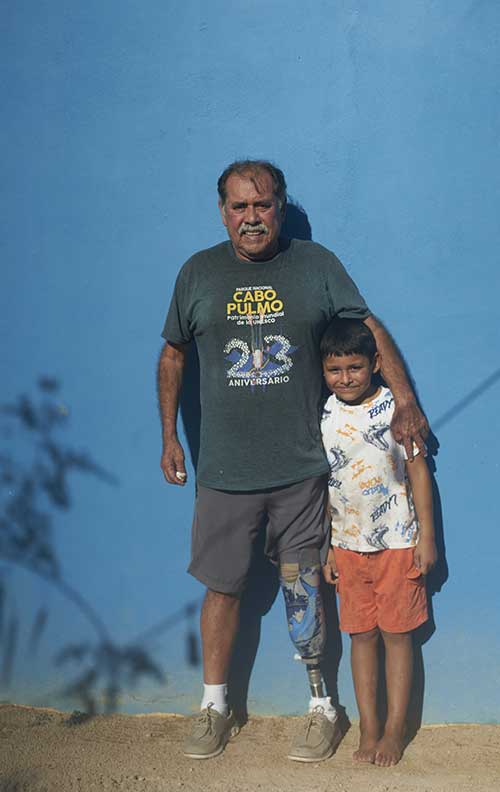
Mario Castro and his grandson, Lian Castro, in Cabo Pulmo—two generations united by conservation. They shifted from fishing to preservation, helping transform the ecosystem into a global model of recovery.
Photo: Eunice Adorno
In just three decades, the village has transformed from a small fishing hamlet into a living conservation laboratory. Families who once cast their nets now run cooperatives, dive shops, restaurants, and educational projects. Women lead, youth prepare, children learn to swim before they learn to write. But success brings new pressures: tourism expands, waters warm, and corals show signs of stress. In response, the community reorganizes—just as it did thirty years ago. “Conservation isn’t defended once; it’s defended every day,” says Judith Castro.
Elsewhere along the Gulf’s coast, echoes of this transformation are beginning to surface. Communities seek to follow the same path: to protect, to learn, to prosper. They’re not looking to replicate the model, but to adapt it in their own way and at their own pace. “Prosperity isn’t a recipe,” says Aburto. “It’s a process that begins with people and ends in the sea.”
The future of the Gulf of California is not guaranteed—but it’s being decided now. Every child who learns that the sea is not inexhaustible helps chart the course for the decades ahead. Perhaps one day Liam will tell the story: that his grandfather was a fisherman, his father dived with sharks, and he learned to protect the reef they all shared. Perhaps then, the sea will speak again—not as a warning, but as a promise kept.